Indium Mineralization in the Xianghualing Sn-Polymetallic Orefield in Southern Hunan, Southern China
Abstract
1. Introduction
2. Geologic Setting
2.1. Geology of the Xianghualing Orefield
2.1.1. Stratigraphy and Structural Geology
2.1.2. Intrusive Rocks
2.1.3. Mineralization Type of the Xianghualing Orefield
Vein-Type Sn–Pb–Zn Orebodies (Type-I)
Porphyry-Type Sn–Pb–Zn Orebodies (Type-II)
2.2. Ore Types and Mineral Paragenetic Sequence
2.2.1. Ores of Type-I Orebodies
2.2.2. Ores of Type-II Orebodies
3. Sampling and Analyses
3.1. Sample Sites
3.2. Whole-Rock Geochemical Analyses
3.3. Electron-Probe Microanalyses
4. Results
4.1. Chemical Composition of Ores
4.1.1. Type-I Orebodies
4.1.2. Type-II Orebodies
4.1.3. Correlations among Significant Elements
4.2. Chemistry of Ore Minerals
4.2.1. Sphalerite
4.2.2. Chalcopyrite
4.2.3. Stannite
5. Discussion
5.1. Indiumenriched Orebody Distribution in the Xianghualing Orefield
5.2. Indium Enriched Minerals in the Xianghualing Orefield
5.3. Genetic Considerations
6. Conclusions
- (1)
- The Xianghualing orefield contains vein and porphyry-type Sn–Pb–Zn orebodies. The former occur in the main faults and are the most In-enriched orebodies, while the latter occur in the granitic porphyry dikes.
- (2)
- Bulk chemical analysis of the ores shows the In content of the vein-type Sn–Pb–Zn orebodies varies from 0.79 to 1680 ppm (avg. 217 ppm, n = 29), and that of the porphyry-type orebodies varies from 10 to 150 ppm (avg. 64 ppm, n = 10).
- (3)
- The EPMA data shows that sphalerite, chalcopyrite, and stannite are In-rich minerals, and sphalerite is the most significant In-rich mineral in the orefield. The most enriched sphalerite contains 7–8 wt % In in its core and up to 21.96 wt % In in its rim, which makes it the most In-enriched sphalerite in southern China. The Cd content of the In-rich sphalerite ranges from 0.35 to 0.45 wt % and exhibits an “Indium window” in the Cu-In-S phases.
- (4)
- The In mineralization of the two types of In-bearing Sn–Pb–Zn orebodies was related to the intrusion of volatile-rich, In-rich, A-type granites and was controlled by normal faults within a magmatic-diapiric extensional structure.
Acknowledgments
Author Contributions
Conflicts of Interest
References
- Taylor, S.R.; McLennan, S.M. The Continental Crust: Its Composition and Evolution; Blackwell Scientific Publication: London, UK, 1985. [Google Scholar]
- Tolcin, A.C. Indium; U.S. Geological Survey: Reston, VA, USA, 2013; pp. 35.1–35.5.
- Chakhmouradian, A.R.; Smith, M.P.; Kynicky, J. From “strategic” tungsten to “green” neodymium: A century of critical metals at a glance. Ore Geol. Rev. 2015, 64, 455–458. [Google Scholar] [CrossRef]
- Schwarz-Schampera, U.; Herzig, P.M. Indium: Geology, Mineralogy, and Economics; Springer: Berlin, Germany, 2002; pp. 1–257. [Google Scholar]
- Ishihara, S.; Hoshino, K.; Murakami, H.; Endo, Y. Resource evaluation and some genetic aspects of indium in the Japanese ore deposits. Resour. Geol. 2006, 56, 347–364. [Google Scholar] [CrossRef]
- Sinclair, W.D.; Kooiman, G.J.A.; Martin, D.A.; Kjarsgaard, I.M. Geology, geochemistry and mineralogy of indium resources at Mount Pleasant, New Brunswick, Canada. Ore Geol. Rev. 2006, 28, 123–145. [Google Scholar] [CrossRef]
- Assadzadeh, G.E.; Samson, I.M.; Gagnon, J.E. Evidence for aqueous liquid-liquid immiscibility in highly evolved tin-bearing granites, Mount Pleasant, New Brunswick, Canada. Chem. Geol. 2017, 448, 123–136. [Google Scholar] [CrossRef]
- Yang, X.M.; Lentz, D.R.; McCutcheon, S.R. Petrochemical evolution of subvolcanic granitoid intrusions within the Late Devonian Mount Pleasant Caldera, southwestern New Brunswick, Canada: Comparison of Au versus Sn-W-Mo-polymetallic mineralization systems. Atlanta Geol. 2003, 39, 97–121. [Google Scholar] [CrossRef]
- Ishihara, S.; Murakami, H.; Marquez-Zavalia, M. Inferred indium resources of the Bolivian tin-polymetallic deposits. Resour. Geol. 2011, 61, 174–191. [Google Scholar] [CrossRef]
- Cook, N.J.; Sundblad, K.; Valkama, M.; Nygård, R.; Ciobanu, C.L.; Danyushevsky, L. Indium mineralization in A-type granites in southeastern Finland: Insights into mineralogy and partitioning between coexisting minerals. Chem. Geol. 2011, 284, 62–73. [Google Scholar] [CrossRef]
- Valkama, M.; Sundblad, K.; Nygård, R.; Nigel, C. Mineralogy and geochemistry of indium-bearing polymetallic veins in the Sarvlaxviken area, Lovisa, Finland. Ore Geol. Rev. 2016, 75, 206–219. [Google Scholar] [CrossRef]
- Valkama, M.; Sundblad, K.; Cook, N.J.; Ivashchenko, V.I. Geochemistry and petrology of the indium-bearing polymetallic skarn ores at Pitkäranta, Ladoga Karelia, Russia. Miner. Depos. 2016, 51, 823–839. [Google Scholar] [CrossRef]
- Andersen, J.C.Ø.; Stickland, R.J.; Rollinson, G.K.; Shail, R.K. Indium mineralization in SW England: Host parageneses and mineralogical relations. Ore Geol. Rev. 2016, 78, 213–238. [Google Scholar] [CrossRef]
- Seifert, T.; Sandmann, D. Mineralogy and geochemistry of indium-bearing polymetallic vein-type deposits: Implications for host minerals from the Freiberg district, Eastern Erzgebirge, Germany. Ore Geol. Rev. 2006, 28, 1–31. [Google Scholar] [CrossRef]
- Oliveira, D.; Matos, J.; Rosa, C.; Rosa, D.; Figueiredo, M.; Silva, T.; Guimaraes, F.; Carvalho, J.; Pinto, A.; Relvas, J.; Reiser, F. The LagoaSalgada orebody, Iberian Pyrite Belt, Portugal. Econ. Geol. 2011, 106, 1111–1128. [Google Scholar] [CrossRef]
- Oliveira, D.; Rosa, D.; Figueiredo, M. Renewable energy technologies for the 21st century: The Iberian Pyrite Belt as a possible supplier of indium. In Proceedings of the 9th Biennial SGA Meeting of the Society for Geology Applied to Mineral Deposits Meeting, Dublin, Ireland, 20–23 August 2007; pp. 1263–1266. [Google Scholar]
- Ishihara, S.; Endo, Y. Indium and other trace elements in volcanogenic massive sulfide ores from the Kuro, Besshi and other types in Japan. Bull. Geol. Surv. Jpn. 2007, 58, 7–22. [Google Scholar] [CrossRef]
- Zhang, Q.; Zhu, X.; He, Y.; Jiang, J.; Wang, D. Indium enrichment with Meng’entaolegai Ag–Pb–Zn deposit, Inner Mongolia, China. Resour. Geol. 2006, 56, 337–346. [Google Scholar] [CrossRef]
- Ishihara, S.; Qin, K.; Wang, Y. Resource evaluation of indium in the Dajing tin-polymetallic deposits, Inner Mongolia, China. Resour. Geol. 2008, 58, 72–79. [Google Scholar] [CrossRef]
- Ishihara, S.; Murakami, H.; Li, X. Indium concentration in zinc ores in plutonic and volcanic environments: Examples at the Dulong and Dachang mines, South China. Bull. Geol. Surv. Jpn. 2011, 62, 259–272. [Google Scholar] [CrossRef]
- Pi, Q.; Hu, R.; Wang, D.; Miao, D.; Qin, X.; Chen, H. Enrichment of indium in west ore belt of Dachang orefield: Evidence from ore textures and sphalerite geochemistry. Miner. Depos. 2015, 34, 379–396. (In Chinese) [Google Scholar]
- Cheng, Y. Occurrence characteristics and enrichment regularity of indium in pyrite: A case study of Dachang tin ore-field. Trans. Nonferrous Met. Soc. China 2016, 26, 2197–2208. [Google Scholar] [CrossRef]
- Liu, J. Indium mineralization in a Sn-poor skarn deposit: A case study of the Qibaoshan deposit, South China. Minerals 2017, 7, 76. [Google Scholar] [CrossRef]
- Liu, J.; Rong, Y.; Gu, X.; Shao, Y.; Lai, J.; Chen, W. Indium mineralization in the Yejiwei Sn-polymetallic deposit of the Shizhuyuan Orefield, southern Hunan, China. Resour. Geol. 2017, 67. in press. [Google Scholar]
- Che, Q.; Li, J.; Wei, S.; Wu, G. Elementary discussion on the tectonic background of deposit-concentrated Qianlishan-Qitianling area in Hunan. Geotect. Met. 2005, 29, 204–214. (In Chinese) [Google Scholar]
- Wang, Y.; Zhu, J.; Yu, Q. Geology of Lead-Zinc Deposits in Hunan Province; Geological Publishing House: Beijing, China, 1988. (In Chinese) [Google Scholar]
- Wang, X.; Wang, W. Geology of the Xianghualing Non-Ferrous and Rare Metals Polymetallic Deposits, Hunan; Bureau of Geological Prospecting of China Nonferrous Metals Industry Corporation: Beijing, China, 1997; pp. 1–76. (In Chinese) [Google Scholar]
- Jiang, S.; Zhao, K.; Jiang, Y.; Dai, B. Characteristics and genesis of Mesozoic A-type granites and associated mineral deposits in the southern Hunan and northern Guangxi provinces along the Shi-Hang belt, south China. Geol. J. China Univ. 2008, 14, 496–509. (In Chinese) [Google Scholar]
- Zhu, J.; Chen, J.; Wang, R.; Lu, J.; Xie, L. Early Yanshanian NE trending Sn/W-bearing A-type granites in the western-middle part of the Nanling Mts region. Geol. J. China Univ. 2008, 14, 474–484. (In Chinese) [Google Scholar]
- Peng, J.; Zhou, M.; Hu, R.; Shen, N.; Yuan, S.; Bi, X.; Du, A.; Qu, W. Precise molybdenite Re–Os and mica Ar–Ar dating of the Mesozoic Yaogangxian tungsten deposit, central Nanling district, South China. Miner. Deposita 2006, 41, 661–669. [Google Scholar] [CrossRef]
- Zhu, J.; Wang, R.; Zhang, P.; Xie, C.; Zhang, W.; Zhao, K.; Xie, L.; Yang, C.; Che, X.; Yu, A.; Wang, L. Zircon U–Pb geochronological framework of Qitianling granite batholith, middle part of Nanling Range, South China. Sci. China Ser. D 2009, 52, 1279–1294. [Google Scholar] [CrossRef]
- Xie, L.; Wang, R.; Chen, J.; Zhu, J. Mineralogical evidence for magmatic and hydrothermal processes in the Qitianling oxidized tin-bearing granite (Hunan, South China): EMP and (MC)-LA-ICPMS investigations of three types of titanite. Chem. Geol. 2010, 276, 53–68. [Google Scholar] [CrossRef]
- Shu, X.; Wang, X.; Sun, T.; Xu, X.; Dai, M. Trace elements, U–Pb ages and Hf isotopes of zircons from Mesozoic granites in the western Nanling Range, South China: Implications for petrogenesis and W–Sn mineralization. Lithos 2011, 127, 468–482. [Google Scholar] [CrossRef]
- Mao, J.; Cheng, Y.; Chen, M.; Pirajno, F. Major types and time–space distribution of Mesozoic ore deposits in South China and their geodynamic settings. Miner. Deposita 2013, 48, 267–294. [Google Scholar]
- Ding, T.; Ma, D.; Lu, J.; Zhang, R. Apatite in granitoids related to polymetallic mineral deposits in southeastern Hunan Province, Shi–Hang zone, China: Implications for petrogenesis and metallogenesis. Ore Geol. Rev. 2015, 69, 104–117. [Google Scholar] [CrossRef]
- Li, H.; Watanabe, K.; Yonezu, K. Geochemistry of A-type granites in the Huangshaping polymetallic deposit (South Hunan, China): Implications for granite evolution and associated mineralization. J. Asian Earth Sci. 2014, 88, 149–167. [Google Scholar] [CrossRef]
- Ding, T.; Ma, D.; Lu, J.; Zhang, R.; Zhang, S. S, Pb, and Sr isotope geochemistry and genesis of Pb–Zn mineralization in the Huangshaping polymetallic ore deposit of southern Hunan Province, China. Ore Geol. Rev. 2016, 77, 117–132. [Google Scholar] [CrossRef]
- Li, X.; Huang, C.; Wang, C.; Wang, L. Genesis of the Huangshaping W–Mo–Cu–Pb–Zn polymetallic deposit in southeastern Hunan Province, China: Constraints from fluid inclusions, trace elements, and isotopes. Ore Geol. Rev. 2016, 79, 1–25. [Google Scholar]
- Yuan, S.; Peng, J.; Hu, R.; Li, H.; Shen, N.; Zhang, D. A precise U–Pb age on cassiterite from the Xianghualing tin-polymetallic deposit (Hunan, South China). Miner. Deposita 2008, 43, 375–382. [Google Scholar] [CrossRef]
- Yuan, S.; Peng, J.; Hao, S.; Li, H.; Geng, J.; Zhang, D. In situ LA-MC-ICP-MS and ID-TIMS U–Pb geochronology of cassiterite in the giant Furong tin deposit, Hunan Province, South China: New constraints on the timing of tin–polymetallic mineralization. Ore Geol. Rev. 2011, 43, 235–242. [Google Scholar] [CrossRef]
- Cai, H. The metallogenic geological setting and approach on ore genesis of the Xianghualing tin-polymetallic ore field. Miner. Resour. Geol. 1991, 5, 272–283. (In Chinese) [Google Scholar]
- Lei, Z.; Xu, Y.; Hu, Z. Analyse prospects of Jijiaoshan tungsten polymetallic deposit of Linwu County, Hunan Province. Geol. Miner. Resour. South China 2008, 4, 36–42. (In Chinese) [Google Scholar]
- Zhu, J.; Wang, R.; Zhang, H.; Zhang, W.; Xie, L.; Zhang, R. Fractionation, evolution, petrogenesis and mineralization of Laiziling granite pluton, southern Hunan province. Geol. J. China Univ. 2011, 17, 381–392. (In Chinese) [Google Scholar]
- Du, S.; Qiu, R. A preliminary study on the evolutionary characteristics of rare earth elements (REE) in granitoid rocks and their formation mechanisms in Xianghualing region, Hunan Province, China. Chin. J. Geochem. 1991, 10, 68–79. [Google Scholar]
- Xu, Q. Identification of the intrusive phases of the composite alkali-feldspathic granite in Xianghualing, Hunan. Hunan Geol. 1991, 10, 289–294. (In Chinese) [Google Scholar]
- Lai, S. Research on Mineralization of the Xianghualing Tin-Polymetallic Deposit, Hunan, China. Ph.D. Thesis, China University of Geosciences (Beijing), Beijing, China, 2014. (In Chinese). [Google Scholar]
- Briskey, J.A. Indium in Zinc-Lead and Other Mineral Deposits; U.S. Geological Survey: Reston, VA, USA, 2005; pp. 1–8.
- Wen, G.; Guo, L.; Ding, C. Preliminary study on mineralization zonation of Xianghualing tin–lead–zinc polymetallic deposit, Liwu County. Hunan Geol. 1984, 3, 18–29. (In Chinese) [Google Scholar]
- Zou, T. Geological characteristics and genesis of granitic porphyry-type tin-polymetallic deposit. In Geological Prospecting and Mineral Economy in China; Sun, Z.J., Ed.; Central South University Press: Changsha, China, 2000; pp. 224–231. (In Chinese) [Google Scholar]
- Zhang, D.; Wang, L. Metallogenic zoning and genesis of the Xianghualing orefield. Miner. Depos. 1988, 7, 35–44. (In Chinese) [Google Scholar]
- Hu, Y.; Huang, R.; Gong, M. Two metal mineralization series endogentic lead–zinc deposits in South Hunan. Hunan Geol. 1984, 3, 5–17. (In Chinese) [Google Scholar]
- Zhong, J.; Li, C. Geological characteristics and genesis of Xianghualing skarn type tin deposit. Miner. Resour. Geol. 2006, 20, 147–151. (In Chinese) [Google Scholar]
- Benzaazoua, M.; Marion, P.; Pinto, A.; Migeon, H.; Wagner, F.E. Tin and indium mineralogy within selected samples from the Neves Corvo ore deposit (Portugal): A multidisciplinary study. Miner. Eng. 2003, 16, 1291–1302. [Google Scholar] [CrossRef]
- Pavlova, G.G.; Palessky, S.V.; Borisenko, A.S.; Vladimirov, A.G.; Seifert, T.; Phan, L.A. Indium in cassiterite and ores of tin deposits. Ore Geol. Rev. 2015, 66, 99–113. [Google Scholar] [CrossRef]
- Dill, H.G.; Garrido, M.M.; Melcher, F.; Gomez, M.C.; Weber, B.; Luna, L.I.; Bahr, A. Sulfidic and non-sulfidic indium mineralization of the epithermal Au–Cu–Zn–Pb–Ag deposit San Roque (Provincia Rio Negro, SE Argentina)—With special reference to the “indium window” in zinc sulfide. Ore Geol. Rev. 2013, 51, 103–128. [Google Scholar] [CrossRef]
- Wen, G.; Li, H.; Li, S. The genesis of Chashan Pb–Zn deposit of Linwu County. Hunan Geol. 1988, 7, 40–47. (In Chinese) [Google Scholar]
- Wen, G.; Wu, Q. The ore-controlling factors and genesis of Paojinshan Pb–Zn deposit, Linwu, Hunan. J. Guilin Inst. Technol. 1990, 10, 356–363. (In Chinese) [Google Scholar]
- Wang, Y.; Duan, J.; Zhou, C. The magmatic-diapiric extensional tectonics of Xianghualing Hunan. Miner. Resour. Geol. 1994, 8, 88–92. (In Chinese) [Google Scholar]
- Murakami, H.; Ishihara, S. Trace elements of indium-bearing sphalerite from tin-polymetallic deposits in Bolivia, China and Japan: A femto-second LA-ICPMS study. Ore Geol. Rev. 2013, 53, 223–243. [Google Scholar] [CrossRef]
- Zhou, T.; Liu, W.; Li, H.; Xu, W.; Dai, T. Isotope geochemistry of the Xianghualing tin-polymetallic deposit in Hunan Province. Acta Geosci. Sin. 2008, 29, 703–708. (In Chinese) [Google Scholar]
- Chen, Y.; He, L.; Sun, W.; Ireland, T.; Tian, X.; Hu, Y.; Yang, W.; Chen, C.; Xu, D. Generation of Late Mesozoic Qianlishan A2-type granite in Nanling Range, South China: Implications for Shizhuyuan W–Sn mineralization and tectonic evolution. Lithos 2016, 266–277, 435–452. [Google Scholar] [CrossRef]
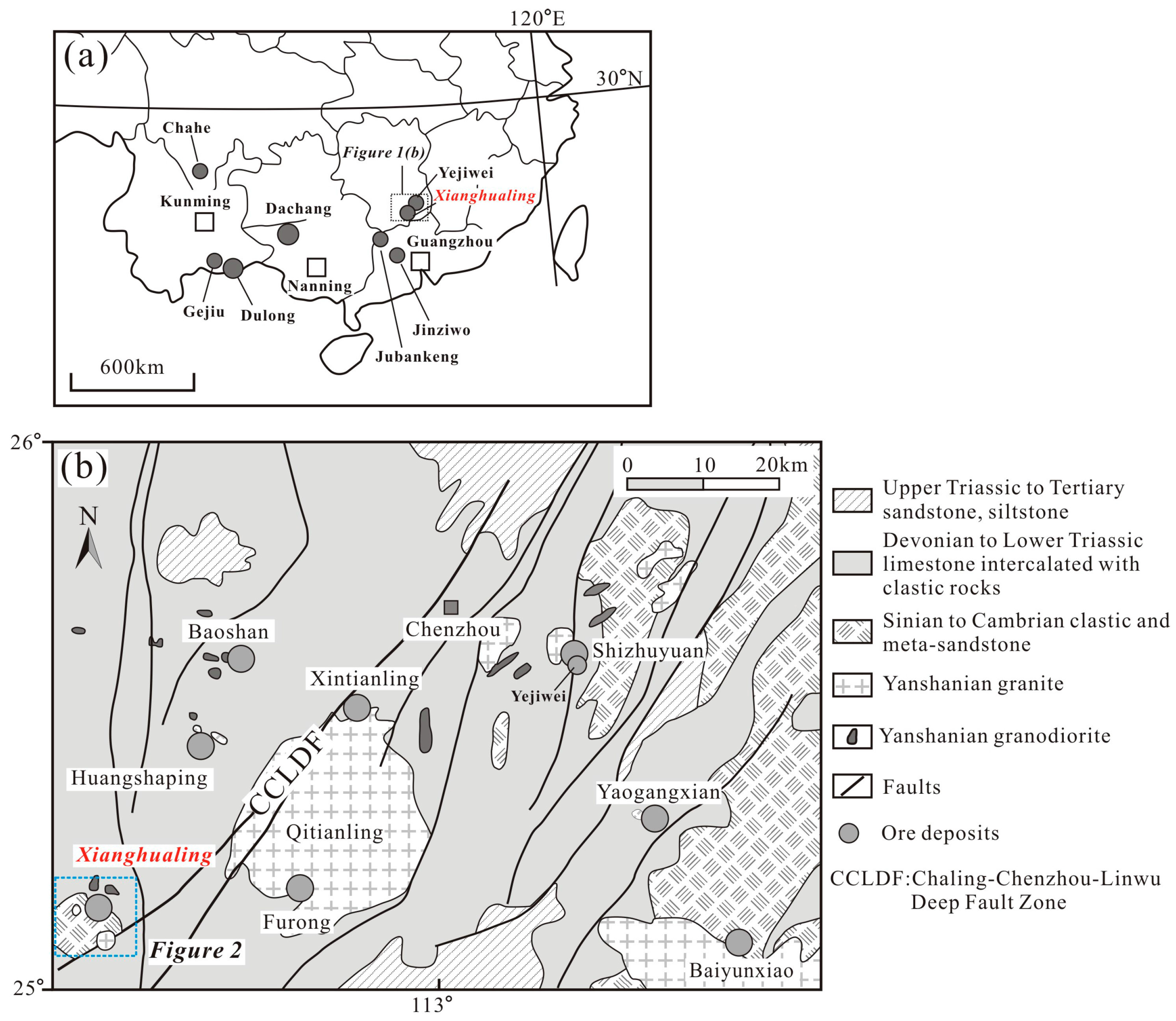
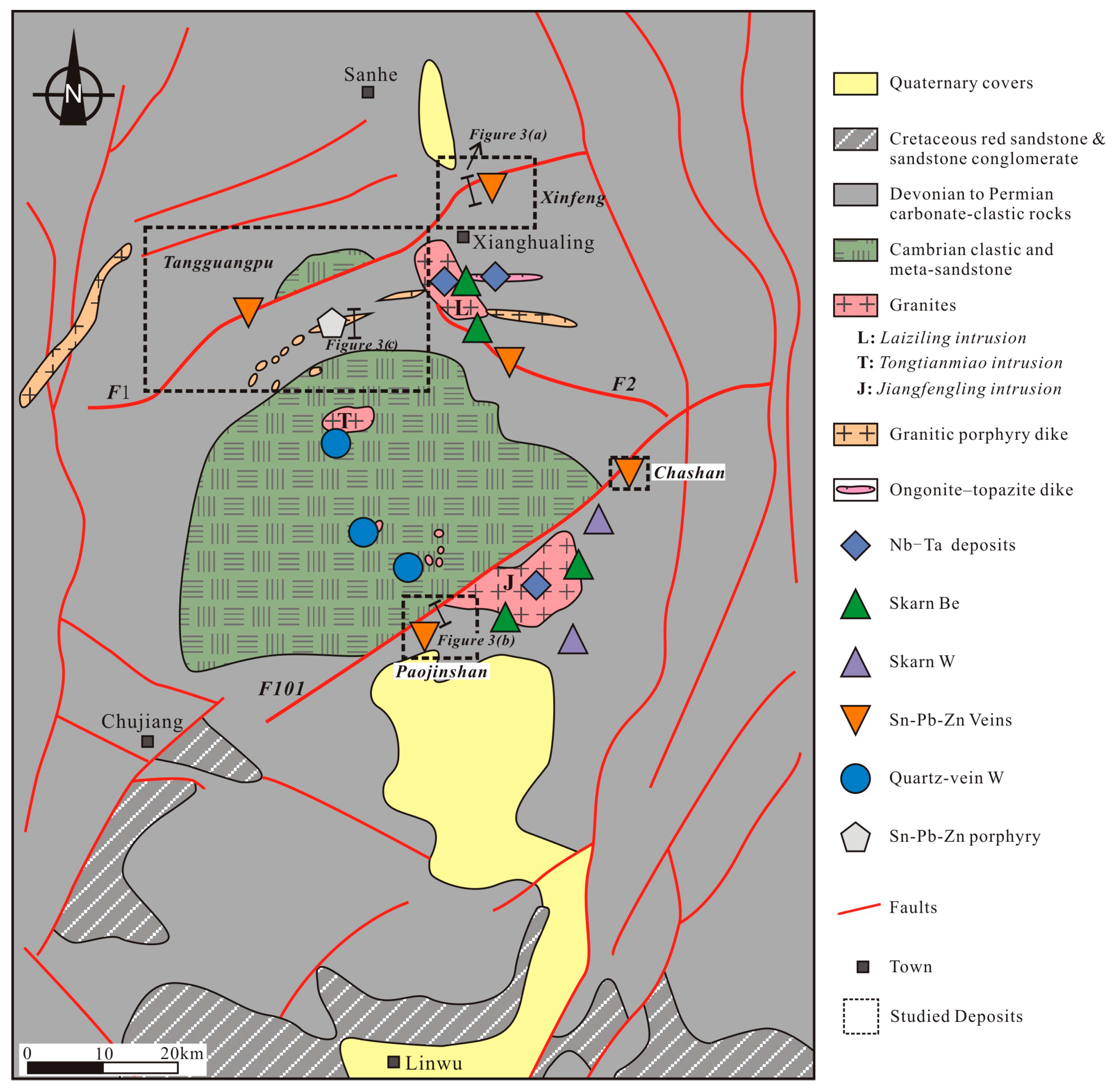
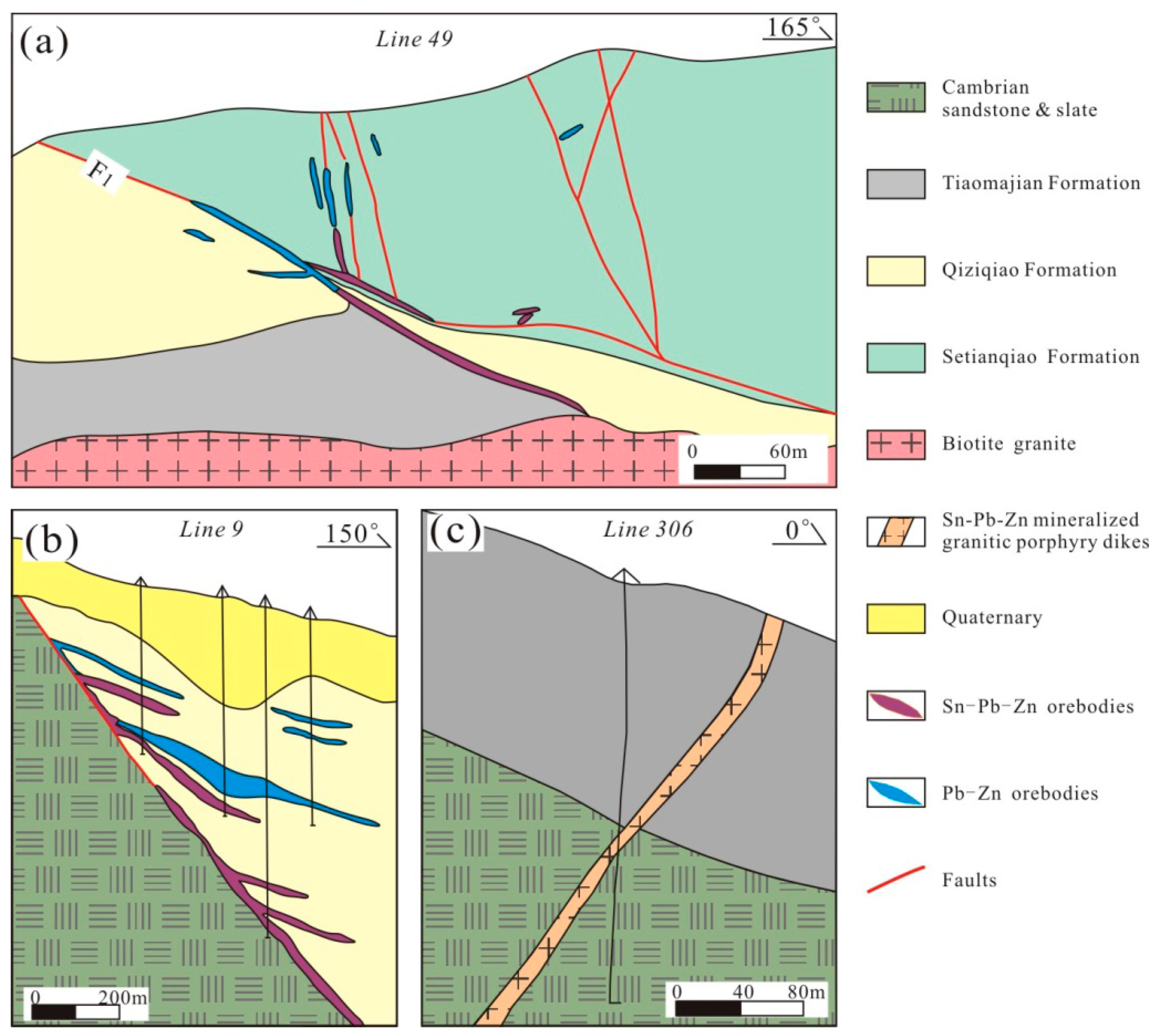
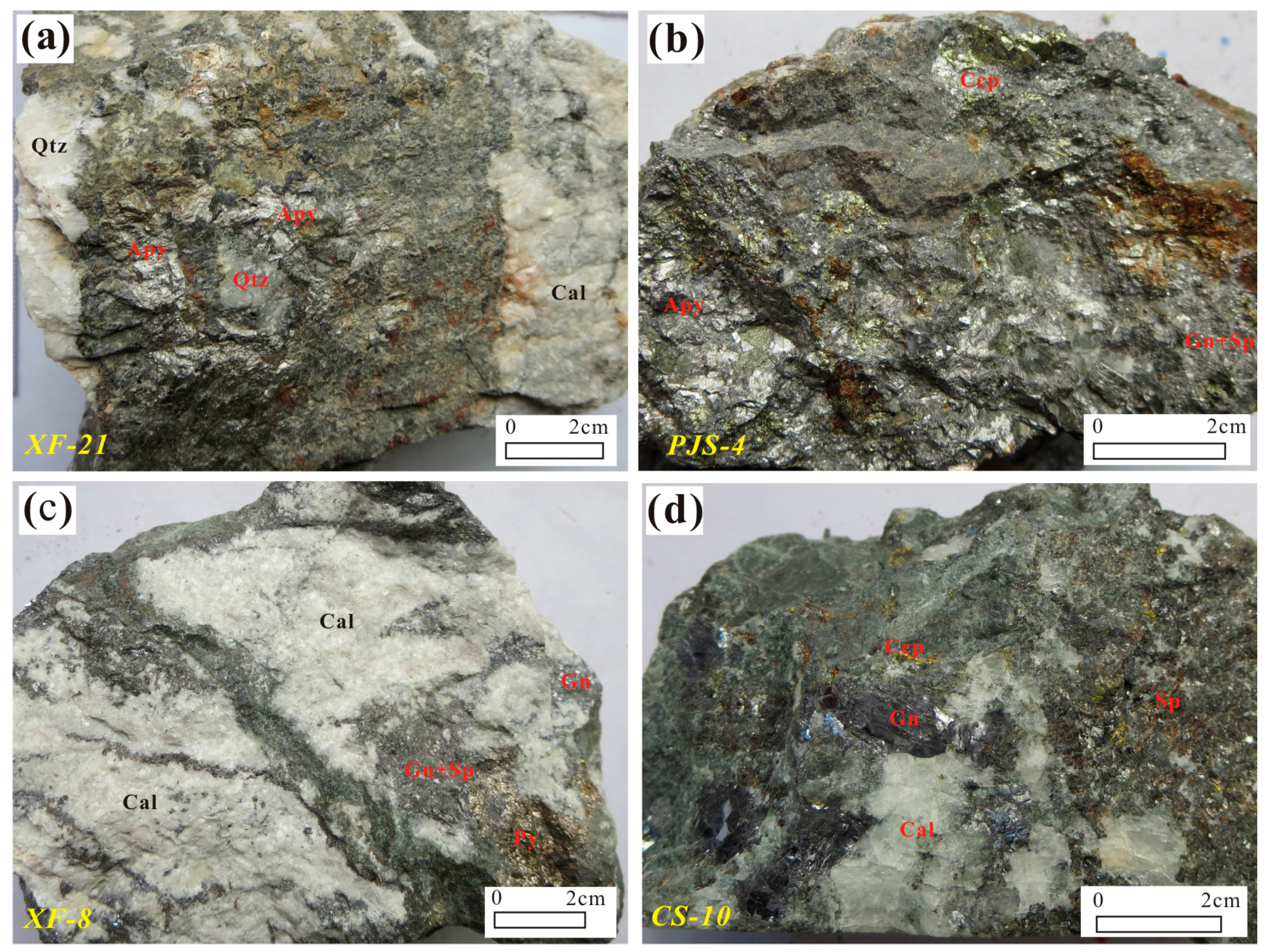
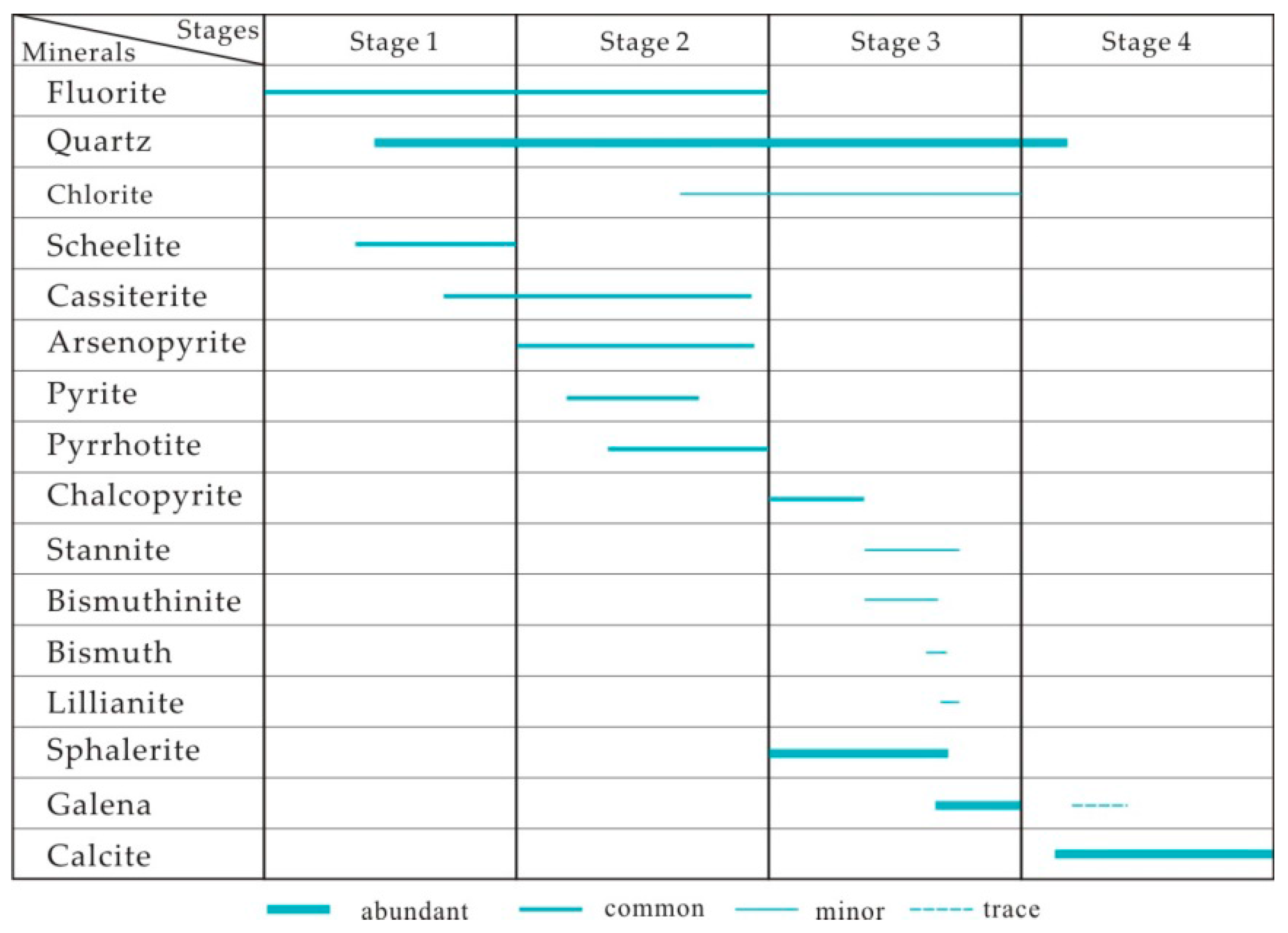
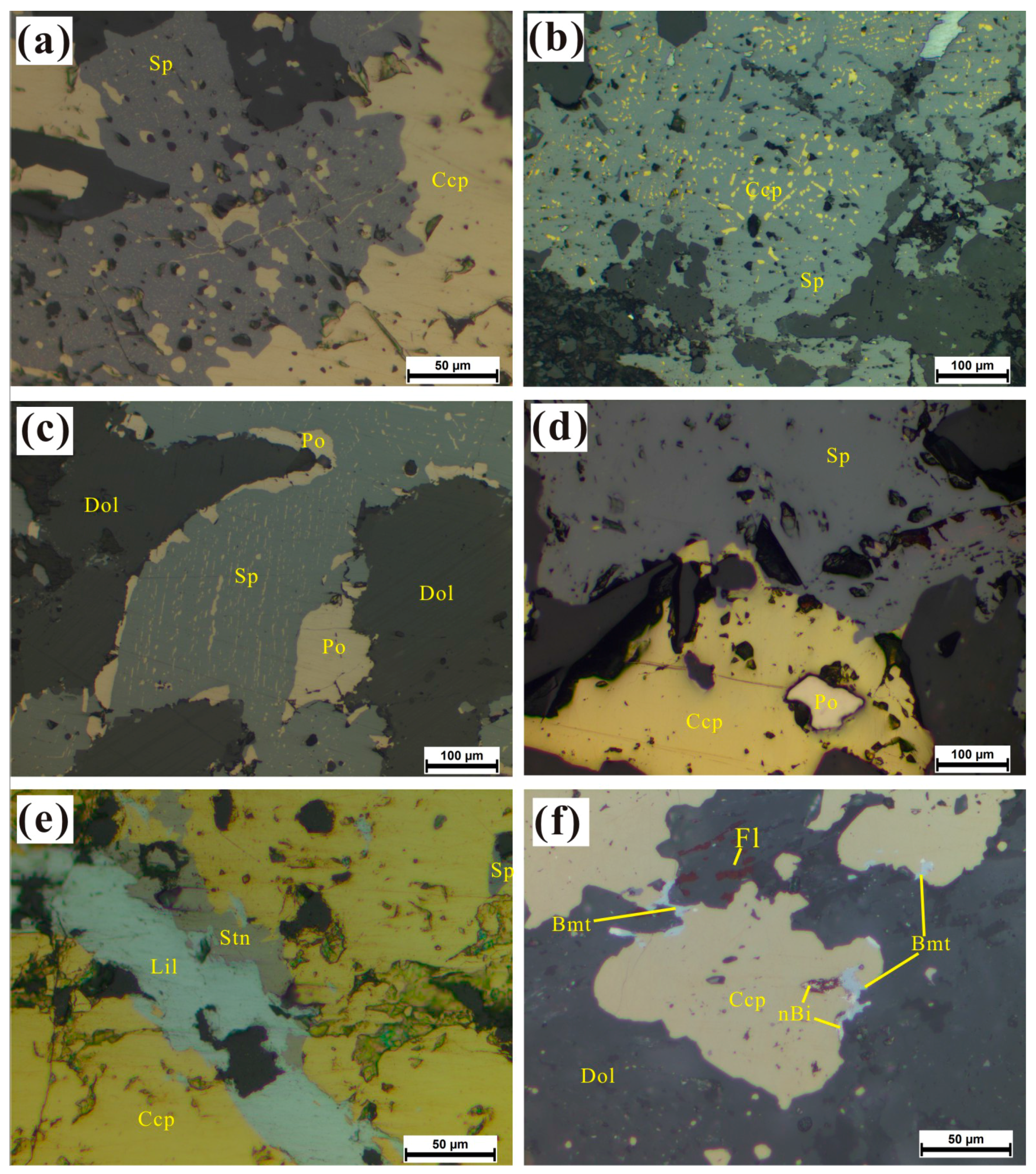
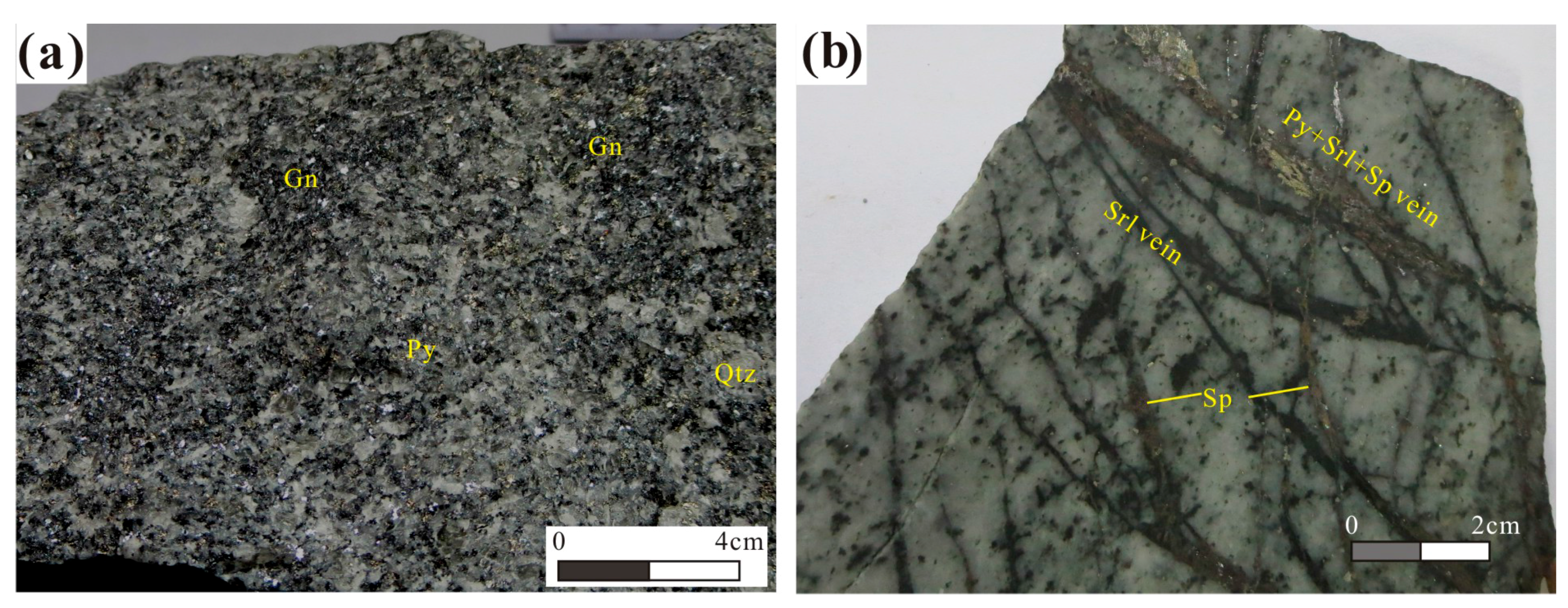
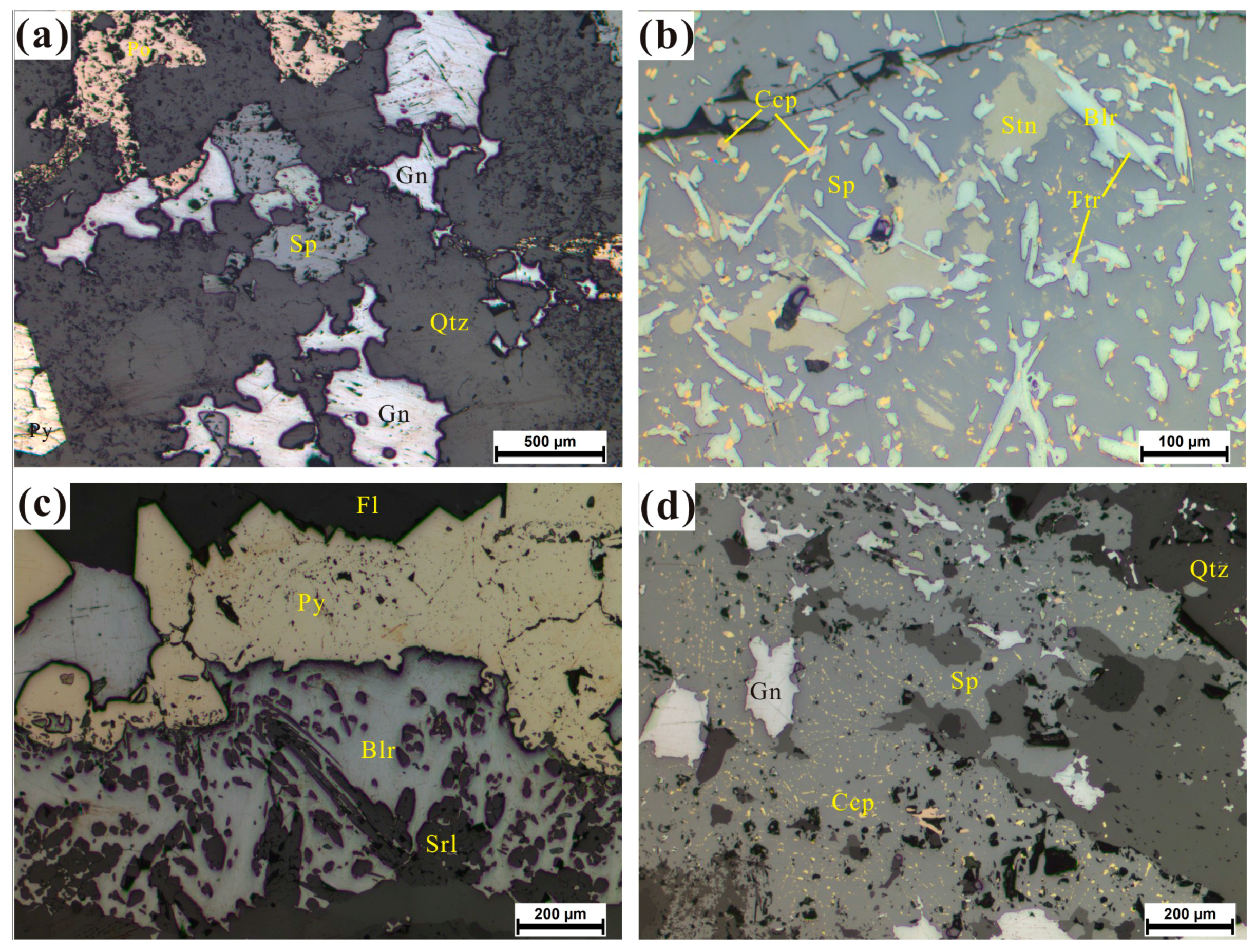

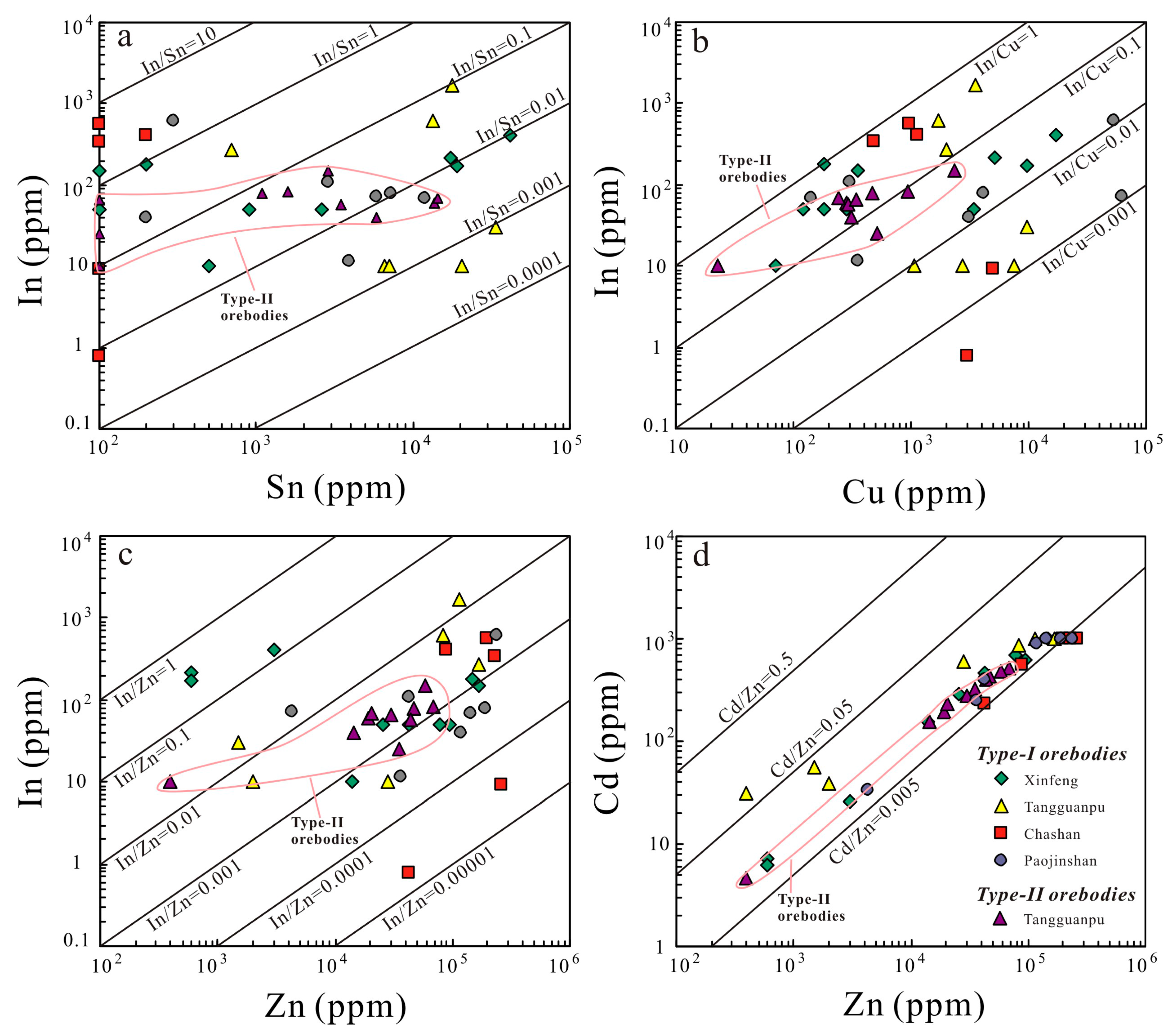
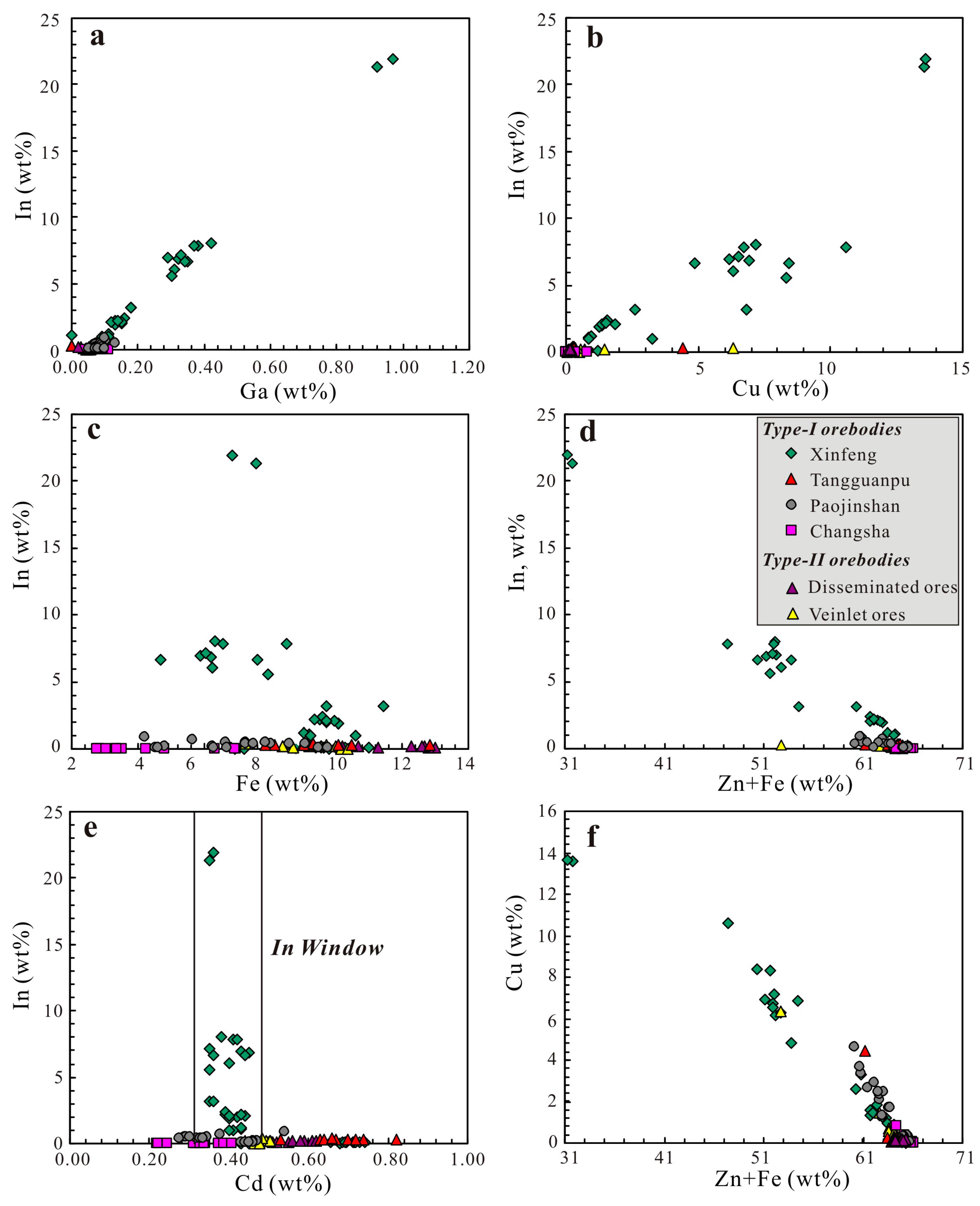
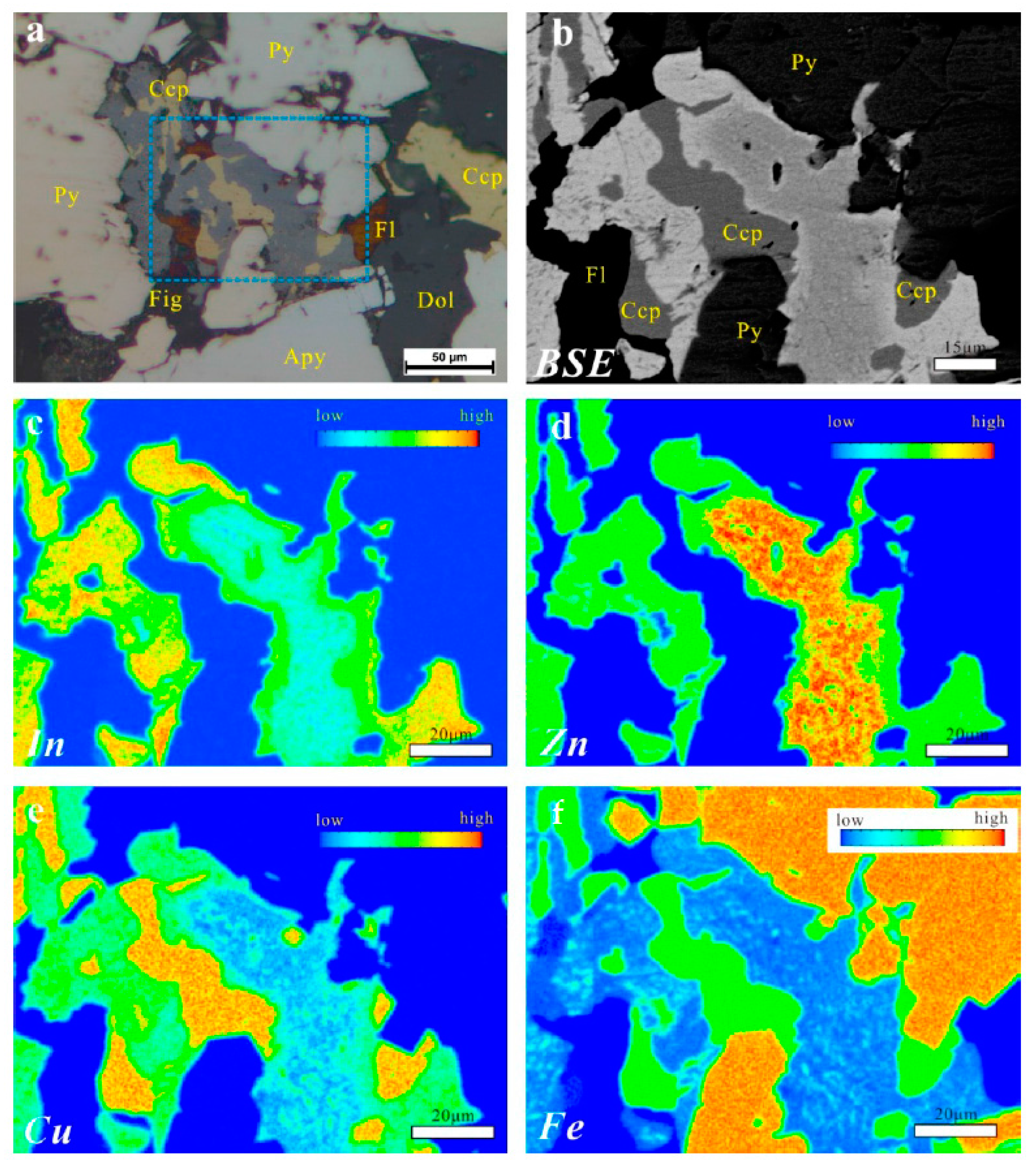
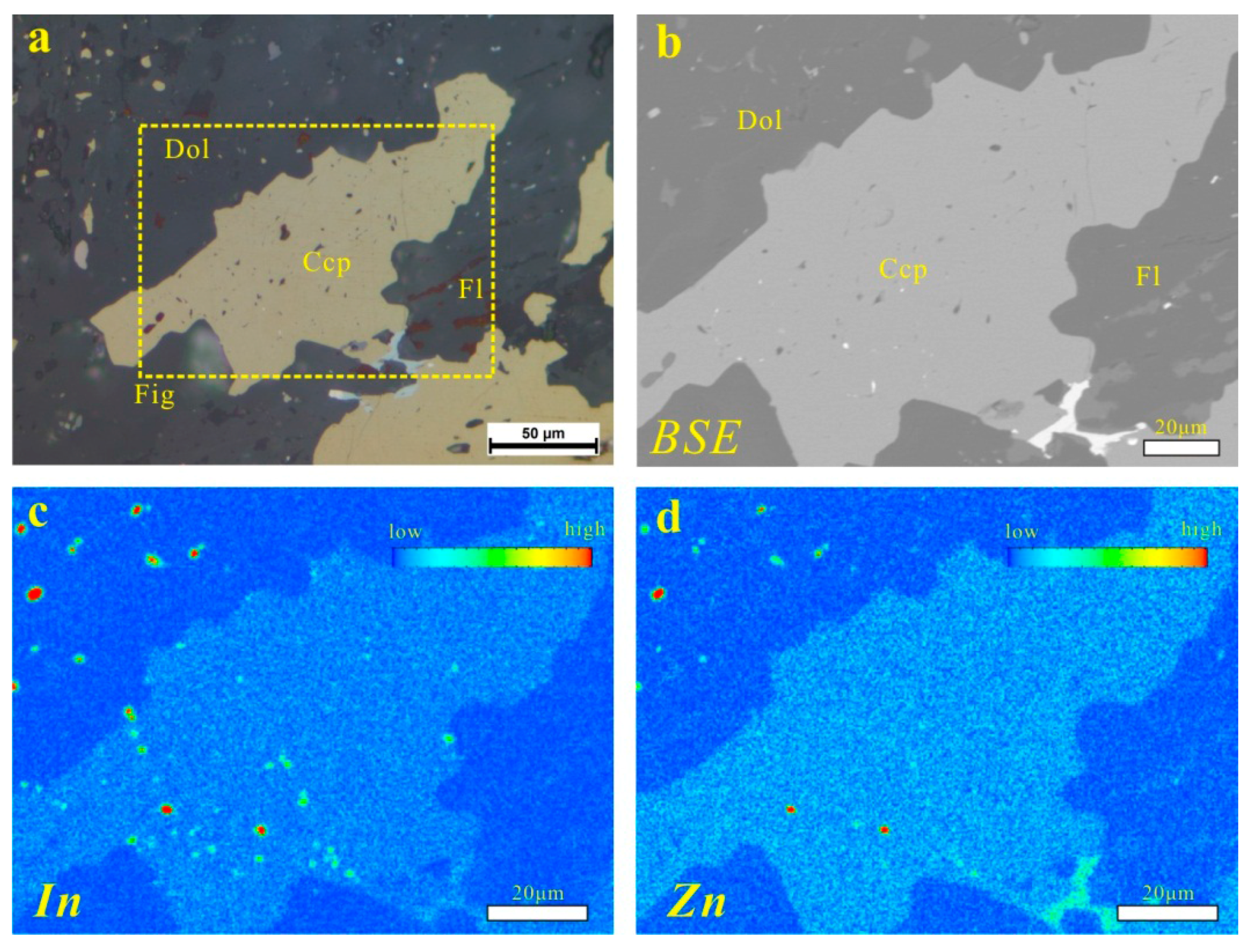
| Sample No. | Location | Ore Types | Oxide and Sulfide Minerals | Associated Gangue | |
|---|---|---|---|---|---|
| Type-I orebodies in Xinfeng deposit | |||||
| 1 | XF3 | 182 m Level | Disseminated Pb–Zn ores | Sp, Gn, Ccp | Qtz, Chl, Cal, Act |
| 2 | XF6 | 182 m Level | Disseminated Pb–Zn ores | Sp, Gn, Py, Po, Sch | Qtz, Fl, Chl, Cal |
| 3 | XF8 | 182 m Level | Marble hosted veinlet Pb–Zn ores | Sp, Gn, Ccp, Po, Py, Apy, Cst | Cal, Qtz |
| 4 | XF12 | 182 m Level | Marble hosted veinlet Pb–Zn ores | Sp, Gn, Py, Po | Chl, Cal, |
| 5 | XF17 | 182 m Level, Line 15 | Marble hosted veinlet Pb–Zn ores | Po, Sp, Apy, Gn | Cal, Chl |
| 6 | XF18 | 182 m Level, Line 17 | Marble hosted veinlet Pb–Zn ores | Gn, Sp, Po, Apy | Cal |
| 7 | XF19 | 182 m Level, Line 51 | Marble hosted veinlet Pb–Zn ores | Gn, Sp, Po, Apy, Py, Cst | Cal |
| 8 | XF21 | 182 m Level, Line 59 | Disseminated Sn ores | Apy, Ccp, Cst, Sp, Py, Bmt, nBi | Qtz, Cal |
| 9 | XF23 | 182 m Level, Line 59 | Disseminated Sn ores | Apy, Py, Ccp, Cst, Sp, Sch, Bmt, nBi | Qtz, Cal |
| 10 | XF25 | 182 m Level, Line 59 | Disseminated Sn ores | Po, Apy, Py, Cst, Ccp, Sp, Bmt, nBi | Qtz, Cal |
| Type-I orebodies in Tangguanpu deposit | |||||
| 11 | TG-1 | 645 m Level, Line 90 | Massive Sn–Pb–Zn ores | Sp, Gn, Apy, Py, Cst, Ccp, Sch | Qtz, Fl |
| 12 | TG-2 | 645 m Level, Line 92 | Disseminated Sn–Pb–Zn ores | Sp, Gn, Apy, Py, Cst, Ccp | Qtz, Fl |
| 13 | GY-1 | 75–100 m Level | Disseminated and vein Sn–Pb–Zn ores | Po, Sp, Gn, Py, Apy, Ccp, Stn | Qtz, Fl |
| 14 | GY-2 | 75–100 m Level | Disseminated Sn–Pb–Zn ores | Gn, Py, Ccp, Apy, Cst, | Qtz |
| 15 | GY-3 | 75–100 m Level | Massive Pb–Zn ores | Sp, Gn, Py, Ccp | Qtz, Cal |
| 16 | GY-4 | 75–100 m Level | Disseminated Sn–Pb–Zn ores | Sp, Gn, Ccp, Cst, Apy, Cst, Py | Qtz, Fl, Cal |
| 17 | GY-5 | 75–100 m Level | Disseminated and vein Sn–Pb–Zn ores | Sp, Gn, Apy, Py, Ccp, Cst, Stn, Sch | Qtz, Fl, Cal |
| Type-I orebodies in Paojinshan deposit | |||||
| 18 | PJS1 | 237 m Level | Disseminated Sn–Pb–Zn ores | Sp, Ccp, Cst, Py, Po | Cal, Act, Qtz |
| 19 | PJS2 | 237 m Level | Disseminated Sn–Pb–Zn ores | Sp, Gn, Cst, Sch | Qtz, Fl, Cal |
| 20 | PJS3 | 237 m Level | Disseminated Sn–Pb–Zn ores | Mag, Sp, Py, Ccp, Cst | Cal, Qtz, Fl, |
| 21 | PJS4 | 237 m Level | Disseminated Sn–Pb–Zn ores | Apy, Ccp, Py, Sp, Gn, Cst, Sch, Stb, Stn | Qtz, Fl, Cal |
| 22 | PJS5 | 237 m Level | Disseminated Sn–Pb–Zn ores | Sp, Gn, Ccp, Py, Apy, Cst | Qtz, Fl, Cal |
| 23 | PJS6 | 237 m Level | Disseminated sulfides and vein Sn–Pb–Zn ores | Sp, Ccp, Apy, Gn, Po, Cst, Py, nBi, Bmt | Qtz, Act, Fl, Cal |
| 24 | PJS20 | 237 m Level | Massive Sn–Pb–Zn ores | Po, Sp, Gn, Apy, Cst, Ccp | Qtz, Cal |
| Type-I orebodies in Chashan deposit | |||||
| 25 | CS5 | 327 m Level | Disseminated Pb–Zn ores | Sp, Gn, Ccp, Po, Sch | Dol, Cal, Fl |
| 26 | CS11 | 330 m Level | Disseminated Pb–Zn ores | Sp, Gn, Apy, Ccp, Py | Dol, Cal, Qtz |
| 27 | CS12 | 330 m Level | Disseminated Pb–Zn ores | Sp, Gn, Apy, Ccp | Dol, Cal, Fl |
| 28 | CS13 | 330 m Level | Disseminated Pb–Zn ores | Sp, Gn, Ccp, Py, Sch | Dol, Cal, Qtz |
| 29 | CS17 | 490 m Level | Disseminated Pb–Zn ores | Sp, Gn, Ccp, Po | Dol, Cal, Fl |
| Type-II orebodies in Tangguanpu deposit | |||||
| 30 | BB1 | 667 m Level, Line 100 | Granitic porphyry hosted disseminated Sn–Pb–Zn ores | Gn, Sp, Po, Cst, Apy | Qtz, Fsp, Fl |
| 31 | BB2 | 667 m Level, Line 100 | Granitic porphyry hosted disseminated Sn–Pb–Zn ores | Sp, Gn, Apy, Cst, Py | Qtz, Fsp, Fl |
| 32 | BB4 | 667 m Level, Line 100 | Granitic porphyry hosted disseminated Sn–Pb–Zn ores | Sp, Gn, Apy, Cst, Py | Qtz, Fsp, Fl |
| 33 | BB5 | 667 m Level, Line 100 | Granitic porphyry hosted disseminated Sn–Pb–Zn ores | Sp, Gn, Apy, Cst, Py | Qtz, Fsp, Fl |
| 34 | TGP6 | No.I dike | Granitic porphyry hosted veinlet Sn–Pb–Zn ores | Sp, Py, Apy, Ccp, Cst, Blr, Gn | Qtz, Cal, Fl |
| 35 | TGP10 | No.I dike | Granitic porphyry hosted veinlet Pb–Zn ores | Sp, Gn, Apy, Blr, | Qtz, Cal, Fl |
| 36 | TGP16 | No.I dike | Granitic porphyry hosted veinlet Pb–Zn ores | Gn, Apy, Blr | Qtz, Srl, Toz, Fl |
| 37 | TGP19 | No.I dike | Granitic porphyry hosted veinlet Pb–Zn ores | Sp, Gn, Apy | Qtz, Cal, Fl |
| 38 | TGP21 | No.I dike | Granitic porphyry hosted veinlet Sn–Pb–Zn ores | Blr, Sp, Py, Apy, Ccp, Stn, Cst | Toz, Qtz, Fl |
| 39 | TGP31 | No.I dike | Granitic porphyry hosted veinlet Pb–Zn ores | Sp, Gn, Apy, Blr, Ccp | Toz, Qtz, Fl |
| 1000In/Zn | In | Sn | Cd | Zn | Pb | Cu | Fe | Mn | Ni | Co | W | Bi | As | Sb | Ag | Mo | Ti | S | |
|---|---|---|---|---|---|---|---|---|---|---|---|---|---|---|---|---|---|---|---|
| Units | ppm | wt % | ppm | wt % | wt % | ppm | wt % | ppm | ppm | ppm | ppm | ppm | wt % | ppm | ppm | ppm | wt % | wt % | |
| Detection Limits | 0.005 | 0.01 | 0.5 | 0.01 | 0.01 | 1 | 0.1 | 5 | 1 | 1 | 10.00 | 2 | 0.01 | 5 | 0.5 | 1 | 0.01 | 0.1 | |
| Type-I orebodies in Xinfeng deposit | |||||||||||||||||||
| XF3 | 0.88 | 150.00 | <0.01 | >1000 | 17.05 | 10.75 | 352 | 9.5 | 6730 | <1 | 33 | 70 | 1090 | 0.06 | <5 | >100 | <1 | <0.01 | 12.0 |
| XF6 | 0.52 | 50.00 | <0.01 | 630.0 | 9.53 | 2.92 | 181 | 6.7 | 3960 | <1 | 9 | 1810 | 178 | <0.01 | <5 | 89.3 | <1 | <0.01 | 6.4 |
| XF8 | 0.64 | 50.00 | 0.26 | 704.0 | 7.77 | 6.20 | 3450 | 9.5 | 14,450 | 1 | <1 | 70 | 23 | 5.55 | 395 | >100 | 2 | <0.01 | 9.4 |
| XF12 | 1.21 | 180.00 | 0.02 | >1000 | 14.85 | 5.59 | 183 | 7.3 | 12,600 | <1 | <1 | 10 | <2 | 0.07 | 132 | >100 | <1 | 0.01 | 11.9 |
| XF17 | 1.17 | 50.00 | 0.01 | 470.0 | 4.26 | 1.48 | 283 | 10.1 | 5680 | 1 | 3 | 20 | 2 | 0.16 | 256 | 83.9 | <1 | <0.01 | 8.4 |
| XF18 | 0.71 | 10.00 | 0.05 | 157.5 | 1.40 | 3.04 | 71 | 2.2 | 5920 | 1 | <1 | <10 | <2 | 0.21 | 355 | >100 | <1 | 0.01 | 2.1 |
| XF19 | 1.98 | 50.00 | 0.09 | 288.0 | 2.52 | 4.11 | 121 | 8.6 | 10,800 | 1 | 5 | 30 | <2 | 3.12 | 395 | 69.1 | <1 | <0.01 | 8.3 |
| XF21 | 366.67 | 220.00 | 1.75 | 7.1 | 0.06 | 0.02 | 5220 | 11.4 | 396 | <1 | 1 | 110 | 339 | 4.75 | 306 | 14.3 | 1 | <0.01 | 7.4 |
| XF23 | 283.33 | 170.00 | 1.89 | 6.3 | 0.06 | 0.01 | 9810 | 30.0 | 279 | <1 | 3 | 1150 | 409 | 7.81 | 72 | 21.2 | 6 | <0.01 | 18.5 |
| XF25 | 136.67 | 410.00 | 4.17 | 26.1 | 0.30 | 0.11 | 17,200 | 29.8 | 675 | <1 | 1 | 60 | 877 | >10.0 | 53 | 81.4 | 9 | <0.01 | 19.8 |
| Mean (n = 10) | 79.38 | 134.00 | 0.83 | 429.9 | 5.78 | 3.42 | 3687 | 12.5 | 6149 | 1 | 6 | 370 | 334 | 3.17 | 197 | 75.9 | 2 | 0.01 | 10.4 |
| Type-I orebodies in Tangguanpu deposit | |||||||||||||||||||
| TG-1 | 14.67 | 1680.00 | 1.76 | >1000 | 11.45 | 11.90 | 3580 | 11.9 | 748 | 3 | 1 | 1000 | 10 | 6.00 | 1175 | >100 | 2 | 0.01 | 17.1 |
| TG-2 | 7.35 | 620.00 | 1.35 | 853.0 | 8.43 | 13.45 | 1730. | 8.5 | 84 | 5 | 9 | 50 | 17 | 6.62 | 2680 | >100 | 2 | <0.01 | 12.7 |
| GY-1 | 0.35 | 10.00 | 0.66 | 603.0 | 2.82 | 2.83 | 1070 | 10.7 | 406 | 12 | 4 | 10 | <2 | <0.01 | 5380 | 88.6 | 1 | 0.22 | 7.9 |
| GY-2 | 5.00 | 10.00 | 0.71 | 38.8 | 0.20 | 14.55 | 2770 | 12.0 | 183 | 2 | 14 | 20 | 124 | >10.0 | 904 | >100 | 2 | <0.01 | 9.4 |
| GY-3 | 1.61 | 270.00 | 0.07 | >1000 | 16.75 | 12.10 | 2020 | 11.1 | 961 | 1 | 1 | 60 | 731 | 7.23 | 299 | >100 | 1 | <0.01 | 16.2 |
| GY-4 | 25.00 | 10.00 | 2.05 | 30.5 | 0.04 | 26.10 | 7560 | 18.1 | 5650 | 54 | 5 | 20 | 310 | 1.74 | 299 | >100 | 11 | 0.07 | 6.7 |
| GY-5 | 20.00 | 30.00 | 3.34 | 55.3 | 0.15 | 24.40 | 9620 | 8.4 | 6020 | 22 | 9 | 6170 | 291 | 3.37 | 406 | >100 | 5 | 0.02 | 9.0 |
| Mean (n = 7) | 10.57 | 375.71 | 1.42 | 511.5 | 5.69 | 15.05 | 4050 | 11.5 | 2007 | 14 | 6 | 1047 | 212 | 5.00 | 1592 | 98.4 | 3 | 0.05 | 11.3 |
| Type-I orebodies in Paojinshan deposit | |||||||||||||||||||
| PJS1 | 0.42 | 80.00 | 0.72 | >1000 | 18.90 | 0.02 | 4080 | 12.3 | 2950 | 4 | <1 | 110 | 197 | 0.88 | 29 | 23.1 | <1 | 0.02 | 12.0 |
| PJS2 | 0.49 | 70.00 | 1.19 | >1000 | 14.15 | 7.98 | 143 | 9.2 | 2390 | 9 | 26 | 1010 | 874 | 0.26 | <5 | >100 | 10 | 0.02 | 9.7 |
| PJS3 | 2.55 | 110.00 | 0.29 | 397.0 | 4.32 | 0.03 | 299 | 23.7 | 4510 | 4 | 1 | 20 | 80 | 0.02 | <5 | 3.0 | <1 | 0.04 | 3.3 |
| PJS4 | 16.42 | 70.60 | 0.58 | 33.6 | 0.43 | 0.96 | 61,500 | 29.9 | 200 | 13 | 31 | 1420 | 1830 | >10.0 | 809 | >100 | 5 | 0.01 | 21.7 |
| PJS5 | 0.34 | 40.00 | 0.02 | 883.0 | 11.75 | 7.37 | 3110 | 7.7 | 1420 | 8 | <1 | 20 | 9 | 6.34 | 729 | >100 | 2 | 0.09 | 11.1 |
| PJS6 | 2.62 | 620.00 | 0.03 | >1000 | 23.70 | 2.61 | 52,400 | 14.8 | 1250 | 19 | 11 | 50 | 1075 | 1.86 | 74 | >100 | 4 | 0.03 | 22.7 |
| PJS20 | 0.32 | 11.55 | 0.39 | 245.0 | 3.63 | 2.23 | 357 | 14.9 | 1100 | 5 | 2 | 17 | 4 | 0.13 | 79 | 63.9 | <1 | 0.10 | 7.9 |
| Mean (n = 7) | 3.31 | 143.16 | 0.46 | 651.2 | 10.98 | 3.03 | 17412 | 16.1 | 1974 | 9 | 10 | 378 | 581 | 1.58 | 247 | 70.0 | 3 | 0.04 | 12.6 |
| Type-I orebodies in Chashan deposit | |||||||||||||||||||
| CS5 | 0.02 | 0.79 | <0.01 | 236.0 | 4.30 | 3.12 | 2990 | 2.8 | 4100 | 3 | 2 | 368 | 5 | 0.02 | 17 | 11.3 | 7 | 0.05 | 3.5 |
| CS11 | 4.63 | 406.00 | 0.02 | 567.0 | 8.76 | 12.20 | 1120 | 17.2 | 8500 | <1 | <1 | <10 | 124 | 0.75 | 164 | >100 | <1 | <0.01 | 16.8 |
| CS12 | 2.77 | 550.00 | 0.01 | >1000 | 19.85 | 6.29 | 968 | 25.5 | 17,400 | 2 | <1 | <10 | 260 | >10.0 | 702 | >100 | 1 | <0.01 | 26.2 |
| CS13 | 0.03 | 9.06 | 0.01 | >1000 | 26.50 | 17.20 | 4960 | 2.8 | 1100 | 1 | 4 | 1010 | 6 | 0.01 | 65 | 55.5 | 2 | 0.02 | 17.4 |
| CS17 | 1.50 | 347.00 | <0.01 | >1000 | 23.10 | 26.20 | 486 | 17.1 | 5800 | <1 | <1 | 20 | <2 | 0.43 | 548 | >100 | <1 | <0.01 | 26.0 |
| Mean (n = 5) | 1.79 | 262.57 | 0.01 | 760.6 | 16.50 | 13.00 | 2104 | 13.1 | 7380 | 2 | 2 | 284 | 79 | 2.2 | 299 | 73.3 | 2 | 0.02 | 18.0 |
| Type-I mean (n = 29) | 31.03 | 216.72 | 0.74 | 559.7 | 8.86 | 7.79 | 6815 | 13.2 | 4354 | 6 | 6 | 508 | 306 | 3.10 | 564 | 79.5 | 3 | 0.03 | 12.5 |
| Type-II orebodies in Tangguanpu deposit | |||||||||||||||||||
| BB1 | 1.70 | 80.00 | 0.11 | 437.0 | 4.70 | 10.00 | 475 | 6.3 | 190 | 1 | 1 | 50 | 25 | 0.64 | 685 | >100 | 2 | <0.01 | 7.6 |
| BB2 | 3.16 | 60.00 | 1.37 | 195.5 | 1.90 | 0.01 | 281 | 5.4 | 118 | 1 | 3 | 120 | 43 | 0.67 | 69 | 9.9 | 3 | <0.01 | 4.1 |
| BB4 | 3.40 | 70.00 | 1.44 | 233.0 | 2.06 | 0.02 | 245 | 4.5 | 124 | 1 | 1 | 10 | 26 | 0.24 | 19 | 9.8 | 3 | <0.01 | 3.6 |
| BB5 | 2.80 | 40.00 | 0.59 | 155.5 | 1.43 | 0.03 | 307 | 6.8 | 265 | 1 | 2 | 50 | 49 | 1.30 | 117 | 10.8 | 3 | <0.01 | 4.4 |
| TGP6 | 1.29 | 56.20 | 0.35 | 397.0 | 4.36 | 1.40 | 295 | 3.8 | 600 | 9 | 30 | 13 | 3 | 0.51 | 1420 | 86.2 | 6 | 0.02 | 3.9 |
| TGP10 | 0.71 | 24.80 | 0.01 | 318.0 | 3.49 | 1.76 | 519 | 11.1 | 1200 | 11 | 115 | 23 | 12 | 3.46 | 496 | 94.1 | 11 | 0.02 | 10.1 |
| TGP16 | 25.00 | 10.00 | <0.01 | 4.7 | 0.04 | 6.31 | 22 | 1.2 | 100 | 20 | 6 | <10 | 20 | 0.63 | 474 | >100 | 3 | 0.02 | 1.5 |
| TGP19 | 1.22 | 83.40 | 0.16 | 524.0 | 6.82 | 10.25 | 929 | 6.6 | 600 | 11 | 10 | 40 | <2 | 0.67 | 25400 | >100 | 1 | 0.29 | 8.5 |
| TGP21 | 2.58 | 152.00 | 0.29 | 481.0 | 5.89 | 13.65 | 2330 | 6.8 | 600 | 10 | 3 | 880 | <2 | 1.51 | 60800 | >100 | 1 | 0.31 | 11.5 |
| TGP31 | 2.15 | 65.70 | <0.01 | 281.0 | 3.05 | 2.77 | 339 | 2.4 | 200 | 3 | 19 | <10 | <2 | 0.30 | 2090 | >100 | 2 | 0.05 | 3.6 |
| Mean (n = 10) | 4.40 | 64.21 | 0.43 | 302.7 | 3.37 | 4.62 | 574 | 5.5 | 400 | 7 | 19 | 121 | 18 | 0.99 | 9157 | 71.1 | 4 | 0.08 | 5.9 |
| Spots | Zn | Fe | Cu | Sn | In | Cd | Mn | Ga | S | Total |
|---|---|---|---|---|---|---|---|---|---|---|
| Sphalerite in type-I orebodies of Xinfeng deposit | ||||||||||
| x3a1 | 56.19 | 8.77 | - | - | - | 0.43 | 0.31 | - | 33.37 | 99.07 |
| x3a2 | 58.18 | 6.81 | 0.05 | - | 0.07 | 0.50 | 0.25 | 0.05 | 33.17 | 99.08 |
| x3a3 | 54.89 | 9.56 | 0.08 | - | 0.18 | 0.50 | 0.34 | 0.08 | 33.33 | 98.96 |
| x3a4 | 58.13 | 7.23 | - | - | 0.02 | 0.43 | 0.25 | 0.05 | 33.06 | 99.17 |
| x3b1 | 52.94 | 10.99 | 0.08 | - | 0.06 | 0.47 | 0.33 | 0.04 | 33.30 | 98.21 |
| x3b2 | 57.53 | 6.92 | 0.04 | - | 0.03 | 0.45 | 0.23 | 0.07 | 33.09 | 98.36 |
| x17a1 | 54.58 | 10.07 | 0.05 | - | 0.08 | 0.73 | 0.37 | 0.06 | 33.37 | 99.31 |
| x17a2 | 54.36 | 10.43 | 0.06 | - | 0.07 | 0.71 | 0.16 | 0.08 | 33.27 | 99.14 |
| x17a3 | 53.91 | 10.12 | 0.06 | - | 0.07 | 0.71 | 0.32 | 0.07 | 33.28 | 98.54 |
| x17a4 | 55.10 | 9.77 | 0.06 | - | 0.05 | 0.68 | 0.28 | 0.07 | 33.67 | 99.68 |
| x17a5 | 55.58 | 9.61 | 0.04 | - | 0.07 | 0.74 | 0.18 | 0.05 | 33.29 | 99.56 |
| x17a6 | 56.02 | 9.40 | 0.11 | - | 0.07 | 0.70 | 0.13 | 0.06 | 33.28 | 99.77 |
| x17b2 | 54.11 | 9.98 | 0.10 | - | 0.07 | 0.72 | 0.26 | 0.04 | 33.19 | 98.47 |
| x17b3 | 53.04 | 10.28 | 1.22 | - | 0.09 | 0.69 | 0.20 | 0.08 | 33.28 | 98.88 |
| x17b4 | 55.30 | 9.55 | 0.09 | - | 0.07 | 0.66 | 0.25 | 0.07 | 33.34 | 99.33 |
| x17b5 | 55.09 | 9.63 | 0.07 | - | 0.08 | 0.69 | 0.08 | 0.07 | 33.17 | 98.88 |
| x21d1 | 44.96 | 6.23 | 6.91 | - | 6.89 | 0.45 | - | - | 32.41 | 97.85 |
| x21d2 | 42.75 | 7.62 | 8.41 | - | 6.64 | 0.36 | - | - | 32.57 | 98.35 |
| x21d3 | 45.72 | 6.35 | 7.15 | - | 8.02 | 0.38 | - | - | 32.37 | 99.99 |
| x21d4 | 46.31 | 5.89 | 6.18 | - | 6.94 | 0.43 | - | - | 32.02 | 97.77 |
| x21d5 | 38.84 | 8.52 | 10.59 | - | 7.81 | 0.41 | - | - | 32.90 | 99.07 |
| x21d1a | 24.23 | 7.56 | 13.57 | - | 21.33 | 0.35 | - | - | 30.65 | 97.69 |
| x21d1b | 24.37 | 6.86 | 13.62 | - | 21.96 | 0.36 | - | - | 30.31 | 97.48 |
| x21d2b | 45.43 | 6.56 | 6.70 | - | 7.82 | 0.42 | - | - | 32.68 | 99.61 |
| x21d2c | 45.88 | 6.05 | 6.54 | - | 7.12 | 0.35 | - | - | 32.42 | 98.36 |
| x21f1 | 46.51 | 6.26 | 6.31 | - | 6.08 | 0.40 | - | - | 32.35 | 97.91 |
| x21f2 | 43.70 | 7.95 | 8.33 | - | 5.57 | 0.35 | - | - | 32.66 | 98.56 |
| x21f3 | 49.15 | 4.68 | 4.85 | - | 6.64 | 0.44 | - | - | 32.11 | 97.87 |
| x25a1 | 52.60 | 9.52 | 1.52 | - | 2.15 | 0.39 | - | - | 33.17 | 99.35 |
| x25a2 | 52.12 | 9.60 | 1.56 | - | 2.40 | 0.39 | - | 0.04 | 32.96 | 99.07 |
| x25a3 | 52.03 | 9.72 | 1.34 | - | 2.00 | 0.42 | - | 0.05 | 33.13 | 98.69 |
| x25b1 | 50.55 | 9.71 | 2.60 | - | 3.13 | 0.35 | - | - | 33.57 | 99.91 |
| x25b2 | 52.87 | 10.05 | 1.26 | - | 1.90 | 0.40 | - | 0.04 | 33.34 | 99.86 |
| x25b3 | 43.02 | 11.45 | 6.84 | - | 3.14 | 0.36 | - | - | 33.21 | 98.02 |
| x25c1 | 52.46 | 9.95 | 1.85 | - | 2.12 | 0.40 | - | 0.04 | 33.49 | 100.31 |
| x25c2 | 52.95 | 9.69 | 1.36 | - | 2.05 | 0.44 | - | - | 33.50 | 99.99 |
| x25c3 | 52.68 | 9.34 | 1.48 | - | 2.16 | 0.43 | - | 0.03 | 33.19 | 99.31 |
| x25d1 | 55.03 | 9.18 | 0.85 | - | 1.08 | 0.43 | - | - | 33.68 | 100.25 |
| x25d2 | 54.43 | 9.02 | 0.97 | - | 1.16 | 0.43 | - | 0.05 | 33.46 | 99.52 |
| x25d3 | 50.24 | 10.57 | 3.28 | - | 0.96 | 0.41 | - | 0.06 | 33.54 | 99.06 |
| x25d4 | 54.85 | 9.23 | 0.86 | - | 0.98 | 0.40 | - | 0.04 | 33.49 | 99.85 |
| Mean (41) | 50.21 | 8.70 | 3.26 | - | 3.48 | 0.48 | 0.25 | 0.05 | 32.97 | 98.98 |
| Sphalerite in type-I orebodies of Tangguangpu deposit | ||||||||||
| tg1a1 | 54.38 | 10.05 | 0.23 | - | 0.33 | 0.63 | 0.14 | - | 33.95 | 99.71 |
| tg1a2 | 48.35 | 12.85 | 4.43 | - | 0.26 | 0.53 | 0.13 | - | 33.87 | 100.42 |
| tg1c1 | 54.96 | 10.47 | 0.30 | - | 0.29 | 0.64 | 0.17 | - | 33.62 | 100.45 |
| tg1c2 | 55.47 | 9.27 | 0.33 | - | 0.33 | 0.70 | 0.18 | - | 33.69 | 99.97 |
| tg1c3 | 54.51 | 9.00 | 0.24 | - | 0.31 | 0.67 | 0.17 | 0.08 | 33.34 | 98.32 |
| tg1c4 | 54.77 | 9.32 | 0.28 | - | 0.35 | 0.66 | 0.16 | 0.06 | 33.36 | 98.96 |
| tg1e1 | 56.85 | 8.13 | 0.29 | - | 0.32 | 0.74 | 0.20 | - | 33.25 | 99.78 |
| tg1e2 | 55.03 | 9.04 | 0.31 | - | 0.31 | 0.72 | 0.16 | 0.04 | 33.50 | 99.11 |
| tg1e3 | 56.62 | 7.86 | 0.22 | - | 0.27 | 0.82 | 0.14 | 0.07 | 33.59 | 99.59 |
| Mean (9) | 54.55 | 9.55 | 0.74 | - | 0.31 | 0.68 | 0.16 | 0.06 | 33.57 | 99.59 |
| Sphalerite in type-I orebodies of Paojingshan deposit | ||||||||||
| p4b1.2 | 54.68 | 8.04 | 2.11 | - | 0.43 | 0.32 | 0.07 | 0.08 | 33.10 | 98.83 |
| p4b1.3 | 53.53 | 7.25 | 3.35 | - | 0.50 | 0.29 | 0.04 | 0.06 | 33.14 | 98.16 |
| p4b1.4 | 55.96 | 6.66 | 2.37 | - | 0.49 | 0.29 | 0.04 | 0.06 | 33.33 | 99.20 |
| p4b1.10 | 57.28 | 5.64 | 1.36 | - | 0.70 | 0.38 | - | 0.08 | 33.01 | 98.45 |
| p4c1.1 | 53.59 | 7.85 | 2.67 | - | 0.47 | 0.35 | - | 0.11 | 33.33 | 98.37 |
| p4c1.3 | 54.48 | 8.60 | 2.47 | - | 0.38 | 0.34 | 0.05 | 0.05 | 32.93 | 99.30 |
| p4c1.4 | 56.38 | 7.24 | 1.69 | - | 0.41 | 0.33 | 0.04 | 0.07 | 32.78 | 98.94 |
| p4c1.5 | 51.12 | 9.05 | 4.61 | - | 0.37 | 0.27 | - | 0.05 | 33.29 | 98.76 |
| p4c1.6 | 54.71 | 7.88 | 2.47 | - | 0.49 | 0.30 | 0.08 | 0.07 | 33.66 | 99.66 |
| p4c1.11 | 56.27 | 7.51 | 1.72 | - | 0.38 | 0.34 | 0.04 | 0.07 | 33.16 | 99.49 |
| p6a1 | 59.35 | 6.24 | 0.33 | - | 0.15 | 0.47 | 0.19 | 0.08 | 33.36 | 100.17 |
| p6a2 | 60.60 | 4.79 | 0.37 | - | 0.16 | 0.46 | 0.16 | 0.06 | 33.39 | 99.99 |
| p6c1 | 56.18 | 9.47 | 0.07 | - | 0.06 | 0.45 | 0.23 | 0.05 | 33.66 | 100.17 |
| p6c2 | 55.34 | 9.76 | 0.10 | - | 0.07 | 0.46 | 0.24 | 0.05 | 33.46 | 99.48 |
| p6c3 | 57.53 | 4.53 | 2.95 | - | 0.09 | 0.43 | 0.10 | 0.08 | 33.21 | 98.92 |
| p6d1 | 58.44 | 6.69 | 0.33 | - | 0.10 | 0.46 | 0.21 | 0.07 | 33.20 | 99.50 |
| p6d2 | 58.68 | 6.30 | 0.30 | - | 0.08 | 0.44 | 0.19 | 0.08 | 33.10 | 99.17 |
| p6d3 | 60.45 | 4.60 | 0.32 | - | 0.09 | 0.45 | 0.14 | 0.10 | 32.85 | 99.00 |
| p6e1 | 56.45 | 4.19 | 3.70 | - | 0.90 | 0.54 | - | 0.06 | 32.97 | 98.81 |
| Mean (19) | 56.37 | 6.96 | 1.75 | - | 0.33 | 0.39 | 0.12 | 0.07 | 33.21 | 99.17 |
| Sphalerite in type-I orebodies of Chashan deposit | ||||||||||
| c3a1 | 62.45 | 3.31 | 0.02 | - | - | 0.38 | 0.16 | - | 33.61 | 99.93 |
| c3a3 | 63.06 | 2.86 | 0.04 | - | - | 0.39 | 0.12 | - | 33.40 | 99.87 |
| c3a5 | 63.13 | 2.82 | - | - | - | 0.41 | 0.11 | - | 32.69 | 99.16 |
| c3b4' | 60.06 | 4.23 | - | - | - | 0.34 | 0.26 | - | 33.38 | 98.27 |
| c3b5' | 60.61 | 4.79 | 0.02 | - | - | 0.32 | 0.34 | - | 32.01 | 98.09 |
| c9sa1 | 58.15 | 6.98 | 0.35 | - | - | 0.22 | 0.35 | - | 32.80 | 98.85 |
| c9sa2 | 57.39 | 6.96 | 0.80 | - | - | 0.22 | 0.28 | - | 32.77 | 98.42 |
| c9sb1 | 59.25 | 6.33 | 0.03 | - | - | 0.24 | 0.35 | - | 33.05 | 99.25 |
| c14a1 | 62.60 | 3.53 | 0.02 | - | - | 0.32 | 0.24 | - | 32.96 | 99.67 |
| c14a2 | 63.11 | 2.76 | - | - | - | 0.31 | 0.08 | - | 33.13 | 99.39 |
| c14c2 | 62.47 | 3.36 | - | - | - | 0.33 | 0.18 | - | 33.28 | 99.62 |
| c14c3 | 62.18 | 3.06 | 0.12 | 0.11 | - | 0.34 | 0.10 | - | 33.21 | 99.12 |
| Mean (12) | 61.21 | 4.25 | 0.18 | 0.11 | - | 0.32 | 0.21 | - | 33.02 | 99.30 |
| Sphalerite in type-II orebodies of Tangguangpu deposit | ||||||||||
| bb1a1 | 52.28 | 13.00 | 0.21 | - | 0.11 | 0.51 | 0.18 | 0.06 | 34.38 | 100.73 |
| bb1a3 | 52.55 | 11.26 | 0.08 | - | 0.10 | 0.55 | 0.07 | 0.05 | 33.86 | 98.52 |
| bb1a4' | 51.66 | 12.80 | 0.07 | - | 0.10 | 0.52 | 0.16 | 0.08 | 33.44 | 98.83 |
| bb2a1 | 52.50 | 12.26 | 0.18 | - | 0.19 | 0.56 | 0.13 | - | 33.65 | 99.47 |
| bb2a2 | 52.26 | 12.66 | 0.16 | - | 0.20 | 0.59 | 0.12 | 0.05 | 33.59 | 99.63 |
| bb2a3 | 52.39 | 12.59 | 0.14 | - | 0.20 | 0.58 | 0.14 | 0.07 | 33.66 | 99.77 |
| bb2b1 | 53.40 | 10.68 | 0.20 | - | 0.19 | 0.61 | 0.04 | 0.06 | 33.67 | 98.85 |
| bb2b2 | 53.85 | 10.20 | 0.14 | - | 0.22 | 0.61 | 0.04 | 0.04 | 33.35 | 98.45 |
| bb2b3 | 54.14 | 10.06 | 0.15 | - | 0.19 | 0.62 | 0.04 | 0.05 | 33.64 | 98.89 |
| t21a1 | 54.00 | 9.56 | 0.71 | 0.53 | 0.21 | 0.46 | 0.17 | 0.08 | 33.39 | 99.11 |
| t21a2 | 43.02 | 9.70 | 6.34 | 5.73 | 0.29 | 0.34 | 0.14 | 0.06 | 32.46 | 98.08 |
| t21a3 | 53.50 | 9.18 | 1.46 | 0.90 | 0.19 | 0.47 | 0.18 | 0.05 | 32.94 | 98.87 |
| t21a4 | 56.06 | 8.40 | 0.18 | - | 0.15 | 0.49 | 0.20 | 0.07 | 33.01 | 98.56 |
| t21a7 | 53.57 | 10.00 | 0.55 | 0.30 | 0.23 | 0.44 | 0.16 | 0.06 | 32.90 | 98.21 |
| t21b1 | 55.62 | 8.71 | 0.14 | - | 0.12 | 0.48 | 0.19 | 0.04 | 33.09 | 98.39 |
| t21b2 | 55.92 | 8.40 | 0.35 | 0.12 | 0.23 | 0.50 | 0.20 | - | 33.15 | 98.87 |
| t21e1 | 57.39 | 7.25 | 0.26 | - | 0.39 | 0.48 | 0.17 | 0.07 | 33.10 | 99.11 |
| t33c1 | 54.03 | 10.13 | 0.50 | - | 0.02 | 0.46 | 0.16 | 0.05 | 32.96 | 98.31 |
| t33c2 | 54.60 | 10.36 | 0.04 | - | - | 0.48 | 0.24 | - | 32.94 | 98.66 |
| Mean (19) | 53.30 | 10.38 | 0.62 | 1.52 | 0.19 | 0.51 | 0.14 | 0.06 | 33.33 | 98.91 |
| Spots | Zn | Fe | Cu | Sn | In | Cd | Mn | S | Total |
|---|---|---|---|---|---|---|---|---|---|
| Chalcopyrite in type-I orebodies, Xinfeng deposit | |||||||||
| x21a1 | - | 30.01 | 34.00 | - | 0.08 | - | - | 35.34 | 99.43 |
| x21a2 | 0.07 | 30.05 | 33.89 | - | 0.04 | - | - | 35.23 | 99.21 |
| x21a3 | 0.12 | 30.17 | 33.83 | - | 0.10 | - | - | 35.25 | 99.35 |
| x21a4 | 0.06 | 30.15 | 34.03 | - | 0.09 | - | - | 35.32 | 99.59 |
| x21a5 | 0.21 | 30.36 | 34.15 | - | 0.08 | - | - | 35.58 | 100.17 |
| x21a6 | 0.08 | 30.21 | 34.07 | - | 0.09 | - | - | 35.41 | 99.78 |
| x21a7 | 0.07 | 30.11 | 33.98 | - | 0.08 | - | - | 35.39 | 99.56 |
| x21f4 | 0.31 | 29.58 | 33.63 | - | 0.09 | - | - | 34.96 | 98.26 |
| x21f5 | 0.26 | 29.62 | 33.78 | - | 0.09 | - | - | 35.18 | 98.67 |
| x21f6 | 0.18 | 29.97 | 33.92 | - | 0.07 | - | - | 35.16 | 99.12 |
| x25a4 | 0.09 | 30.23 | 33.91 | - | 0.07 | - | - | 35.15 | 99.36 |
| x25a5 | 0.45 | 29.42 | 33.80 | - | 0.07 | - | - | 34.73 | 98.02 |
| x25a6 | 0.17 | 30.14 | 34.00 | - | 0.07 | - | - | 34.85 | 99.06 |
| x25a7 | 0.43 | 29.43 | 33.93 | - | 0.40 | - | - | 34.93 | 98.69 |
| x25b4 | 0.54 | 30.11 | 33.74 | - | 0.06 | - | - | 35.30 | 99.21 |
| x25b5 | 0.06 | 30.38 | 33.96 | - | 0.06 | - | - | 35.22 | 99.62 |
| x25b6 | 0.08 | 30.29 | 34.20 | - | 0.08 | - | - | 35.32 | 99.89 |
| x25d5 | 0.23 | 30.12 | 34.16 | - | 0.06 | - | - | 35.48 | 99.82 |
| x25d6 | 0.05 | 30.36 | 34.39 | - | 0.07 | - | - | 35.36 | 100.18 |
| x25d7 | 0.15 | 30.01 | 33.93 | - | 0.21 | - | - | 35.28 | 99.58 |
| x25d8 | 0.07 | 29.87 | 34.03 | - | 0.10 | - | - | 34.97 | 98.97 |
| Mean (n = 21) | 0.18 | 30.03 | 33.97 | - | 0.10 | - | - | 35.20 | 99.31 |
| Chalcopyrite in type-I orebodies, Tangguangpu deposit | |||||||||
| gy5a1 | 0.10 | 30.39 | 33.98 | - | 0.03 | - | - | 35.30 | 99.72 |
| gy5a2 | 0.07 | 30.29 | 33.71 | - | - | - | - | 35.13 | 99.13 |
| gy5a3 | 0.04 | 30.55 | 33.82 | - | - | - | - | 35.01 | 99.38 |
| gy2b5 | 0.10 | 29.37 | 33.08 | - | 0.07 | - | - | 35.64 | 98.16 |
| gy2b6 | 0.09 | 29.45 | 33.23 | - | 0.07 | - | - | 35.65 | 98.40 |
| gy2b8 | 0.05 | 29.29 | 33.33 | - | 0.07 | - | - | 35.57 | 98.26 |
| Mean (n = 6) | 0.08 | 29.89 | 33.53 | - | 0.04 | - | - | 35.38 | 98.84 |
| Chalcopyrite in type-I orebodies, Paojinshan deposit | |||||||||
| p4a1.10 | 0.09 | 29.70 | 33.22 | - | 0.05 | - | - | 34.92 | 97.89 |
| p4a1.11 | 0.58 | 29.41 | 33.19 | - | 0.05 | - | - | 35.12 | 98.35 |
| p4b1.5 | 0.10 | 29.39 | 33.30 | - | 0.10 | - | - | 35.12 | 98.01 |
| p4b1.7 | 0.16 | 29.70 | 33.27 | - | 0.07 | - | - | 34.94 | 98.14 |
| p4b1.8 | 0.04 | 29.57 | 33.44 | - | 0.09 | - | - | 34.92 | 98.06 |
| p4b1.9 | 0.06 | 29.69 | 33.70 | - | 0.10 | - | - | 35.30 | 98.85 |
| p4c1.7 | 0.11 | 29.89 | 33.84 | - | 0.11 | - | - | 35.13 | 99.08 |
| p4c1.8 | 0.04 | 29.95 | 33.68 | - | 0.08 | - | - | 35.24 | 98.99 |
| p4c1.9 | 0.03 | 29.93 | 33.36 | - | 0.08 | - | - | 34.95 | 98.35 |
| p4c1.10 | 0.07 | 30.01 | 33.72 | - | 0.10 | - | - | 35.13 | 99.03 |
| p6a3 | 0.04 | 30.11 | 33.82 | 0.08 | 0.05 | - | - | 35.30 | 99.40 |
| p6a4 | 0.16 | 30.05 | 33.91 | 0.08 | 0.07 | - | - | 35.01 | 99.28 |
| p6a5 | 0.03 | 30.07 | 34.01 | - | 0.07 | - | - | 35.21 | 99.39 |
| p6d4 | 0.09 | 29.85 | 33.66 | - | 0.02 | - | - | 35.35 | 98.97 |
| p6d5 | 0.08 | 30.02 | 33.54 | - | 0.04 | - | - | 35.75 | 99.43 |
| p6d6 | 0.03 | 30.04 | 33.43 | - | 0.02 | - | - | 35.47 | 98.99 |
| p6e2 | 0.08 | 29.96 | 34.06 | 0.07 | 0.09 | - | - | 35.12 | 99.38 |
| p6e3 | 0.03 | 30.04 | 33.77 | - | 0.05 | - | - | 35.29 | 99.18 |
| p6e4 | 0.03 | 29.93 | 33.85 | 0.07 | 0.05 | - | - | 35.23 | 99.16 |
| Mean (n = 19) | 0.10 | 29.86 | 33.62 | 0.08 | 0.07 | - | - | 35.18 | 98.89 |
| Chalcopyrite in type-I orebodies, Chashan deposit | |||||||||
| c3-b1 | 0.06 | 29.76 | 33.90 | - | - | - | - | 35.47 | 99.19 |
| c3-b2 | 0.03 | 29.91 | 33.90 | - | - | - | - | 35.94 | 99.78 |
| c3-b3 | 0.08 | 29.44 | 33.51 | - | - | - | - | 35.99 | 99.02 |
| c3-a6 | 0.10 | 30.09 | 34.21 | - | - | - | - | 35.66 | 100.06 |
| c3-a7 | 0.05 | 30.25 | 34.13 | - | - | - | - | 35.49 | 99.92 |
| c3-a8 | 0.79 | 29.71 | 33.53 | - | - | - | - | 35.72 | 99.75 |
| c9sa3 | 0.10 | 30.01 | 33.91 | - | - | - | - | 34.83 | 98.85 |
| c9sa4 | 0.14 | 30.07 | 33.81 | - | - | - | - | 35.08 | 99.10 |
| c14c1 | 0.08 | 30.04 | 33.81 | - | - | - | - | 35.28 | 99.21 |
| c14-c4 | 0.17 | 30.25 | 34.20 | - | - | - | - | 35.34 | 99.96 |
| Mean (n = 10) | 0.16 | 29.95 | 33.89 | - | - | - | - | 35.48 | 99.48 |
| Data | Zn | Fe | Cu | Sn | In | Cd | Mn | Ga | S | Total |
|---|---|---|---|---|---|---|---|---|---|---|
| Stannite in type-I orebodies, Tangguangpu deposit | ||||||||||
| gy2a5 | 1.41 | 11.82 | 28.22 | 27.27 | - | 0.17 | - | 0.03 | 30.32 | 99.24 |
| gy2a8' | 0.83 | 12.81 | 29.13 | 27.10 | - | 0.14 | - | - | 30.58 | 100.59 |
| gy2a9 | 0.83 | 12.91 | 28.84 | 27.51 | - | 0.07 | - | - | 30.32 | 100.48 |
| gy2b1 | 1.13 | 12.66 | 28.91 | 25.33 | 0.31 | 0.25 | - | - | 30.00 | 98.59 |
| gy2b2 | 1.02 | 12.42 | 29.03 | 26.45 | 0.17 | 0.19 | - | - | 30.21 | 99.49 |
| gy2b3 | 1.30 | 12.73 | 29.08 | 26.31 | 0.06 | 0.22 | - | - | 30.46 | 100.16 |
| gy5a4 | 1.98 | 11.60 | 29.43 | 27.06 | 0.03 | 0.06 | - | - | 30.09 | 100.25 |
| gy5a5 | 2.27 | 12.04 | 29.45 | 26.76 | - | 0.04 | - | - | 30.19 | 100.75 |
| gy5a6 | 1.96 | 12.30 | 28.70 | 26.07 | - | 0.04 | - | - | 29.96 | 99.03 |
| Mean (9) | 1.41 | 12.37 | 28.98 | 26.65 | 0.14 | 0.13 | - | 0.03 | 30.24 | 99.95 |
| Stannite in type-I orebodies, Paojinshan deposit | ||||||||||
| p4a1.3 | 2.87 | 11.47 | 27.72 | 26.49 | 0.14 | 0.05 | - | 0.03 | 30.03 | 98.80 |
| p4a1.4 | 1.70 | 11.56 | 28.66 | 26.65 | 0.10 | 0.05 | - | - | 30.12 | 98.84 |
| p4a1.5 | 1.79 | 11.94 | 28.91 | 26.80 | 0.11 | 0.03 | - | - | 30.11 | 99.69 |
| p4a1.6 | 2.77 | 11.58 | 28.19 | 26.36 | 0.24 | 0.06 | - | - | 99.04 | 29.84 |
| p4a1.7 | 1.55 | 11.52 | 28.35 | 26.82 | 0.14 | 0.06 | - | - | 29.60 | 98.04 |
| p4b1.1 | 5.00 | 11.06 | 25.77 | 22.99 | 3.68 | 0.06 | - | 0.13 | 30.28 | 98.97 |
| p4b1.2 | 4.13 | 11.60 | 26.53 | 23.25 | 3.41 | 0.07 | - | 0.13 | 30.06 | 99.18 |
| p4c1.2 | 1.53 | 13.10 | 29.28 | 26.66 | 0.23 | - | - | - | 29.74 | 100.54 |
| Mean (8) | 2.67 | 11.73 | 27.93 | 25.75 | 1.01 | 0.05 | - | 0.10 | 29.97 | 99.14 |
| Stannite in type-II orebodies, Tangguangpu deposit | ||||||||||
| bb2b4 | 1.16 | 12.78 | 28.17 | 27.03 | - | 0.06 | - | - | 30.05 | 99.25 |
| bb2b5 | 1.66 | 12.56 | 28.06 | 26.43 | - | - | - | - | 30.21 | 98.92 |
| bb2b6 | 1.51 | 13.04 | 27.78 | 26.42 | 0.26 | 0.04 | - | - | 29.84 | 98.89 |
| t21a8 | 4.80 | 11.60 | 27.43 | 25.14 | 0.13 | 0.06 | - | - | 30.28 | 99.44 |
| t21a9 | 4.84 | 11.50 | 27.33 | 25.04 | 0.10 | 0.06 | - | 0.04 | 29.97 | 98.88 |
| t21a10 | 3.15 | 11.73 | 28.42 | 25.61 | 0.07 | 0.06 | - | - | 29.78 | 98.82 |
| t21a11 | 4.44 | 11.51 | 27.60 | 25.46 | 0.14 | 0.08 | - | - | 29.90 | 99.13 |
| Mean (7) | 3.08 | 12.10 | 27.83 | 25.88 | 0.14 | 0.06 | - | 0.04 | 30.00 | 99.05 |
© 2017 by the authors. Licensee MDPI, Basel, Switzerland. This article is an open access article distributed under the terms and conditions of the Creative Commons Attribution (CC BY) license (http://creativecommons.org/licenses/by/4.0/).
Share and Cite
Liu, J.; Rong, Y.; Zhang, S.; Liu, Z.; Chen, W. Indium Mineralization in the Xianghualing Sn-Polymetallic Orefield in Southern Hunan, Southern China. Minerals 2017, 7, 173. https://doi.org/10.3390/min7090173
Liu J, Rong Y, Zhang S, Liu Z, Chen W. Indium Mineralization in the Xianghualing Sn-Polymetallic Orefield in Southern Hunan, Southern China. Minerals. 2017; 7(9):173. https://doi.org/10.3390/min7090173
Chicago/Turabian StyleLiu, Jianping, Yanan Rong, Shugen Zhang, Zhongfa Liu, and Weikang Chen. 2017. "Indium Mineralization in the Xianghualing Sn-Polymetallic Orefield in Southern Hunan, Southern China" Minerals 7, no. 9: 173. https://doi.org/10.3390/min7090173
APA StyleLiu, J., Rong, Y., Zhang, S., Liu, Z., & Chen, W. (2017). Indium Mineralization in the Xianghualing Sn-Polymetallic Orefield in Southern Hunan, Southern China. Minerals, 7(9), 173. https://doi.org/10.3390/min7090173





